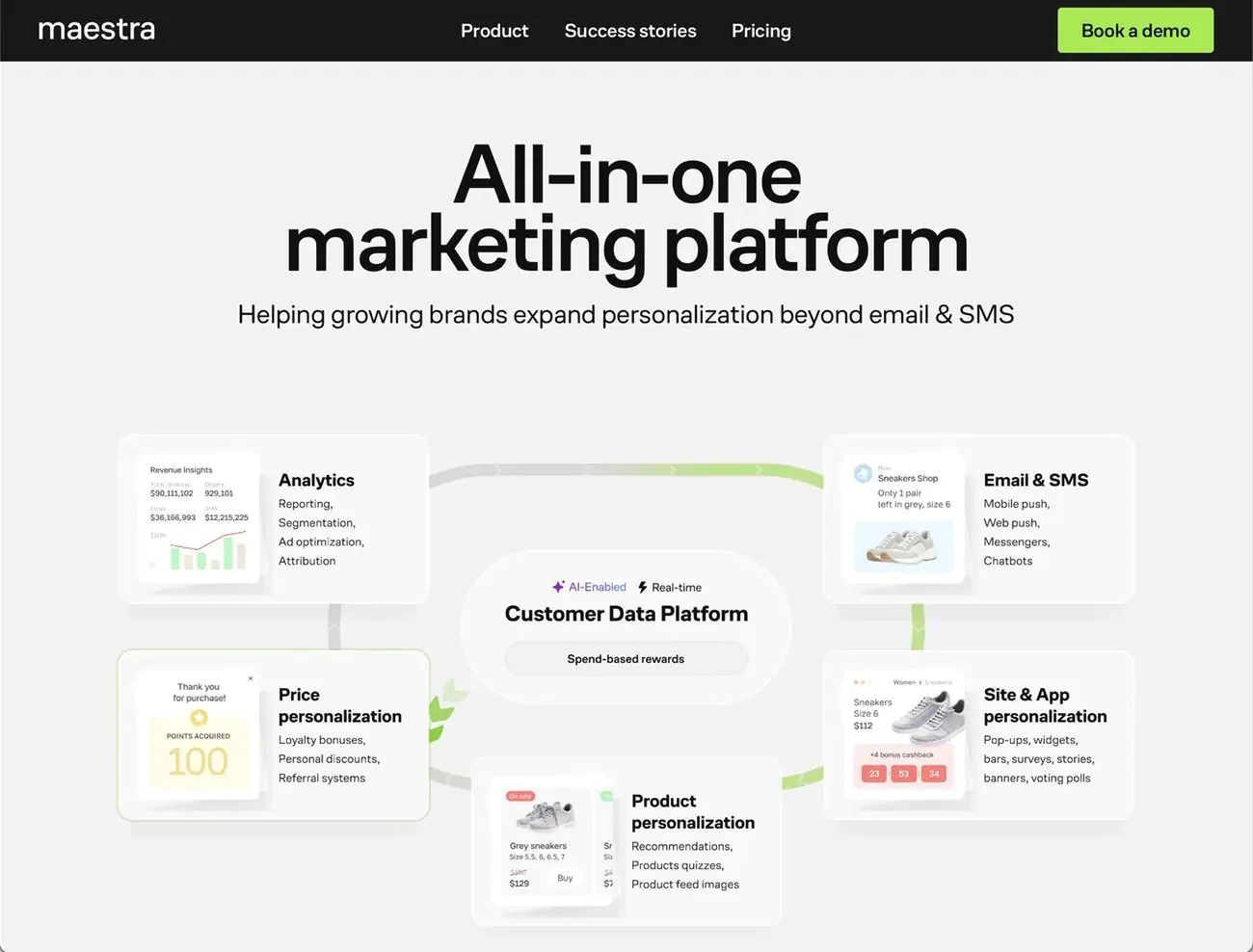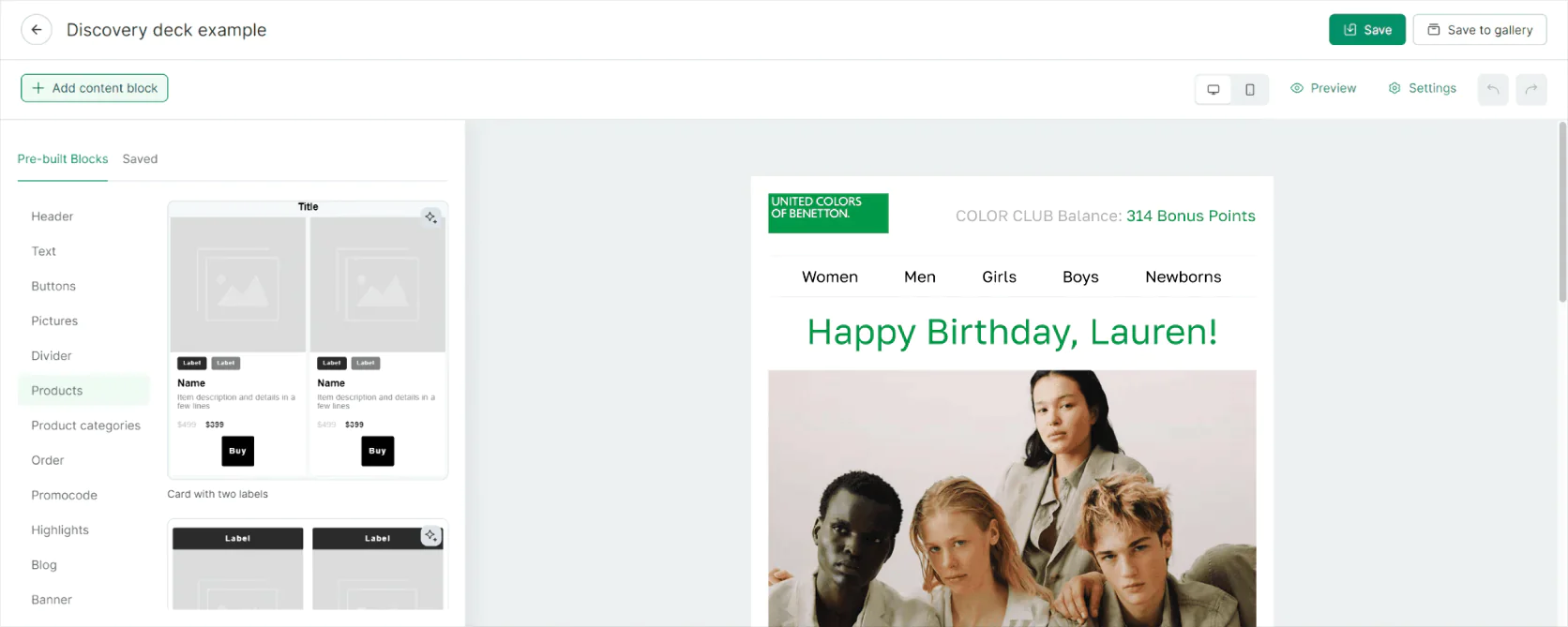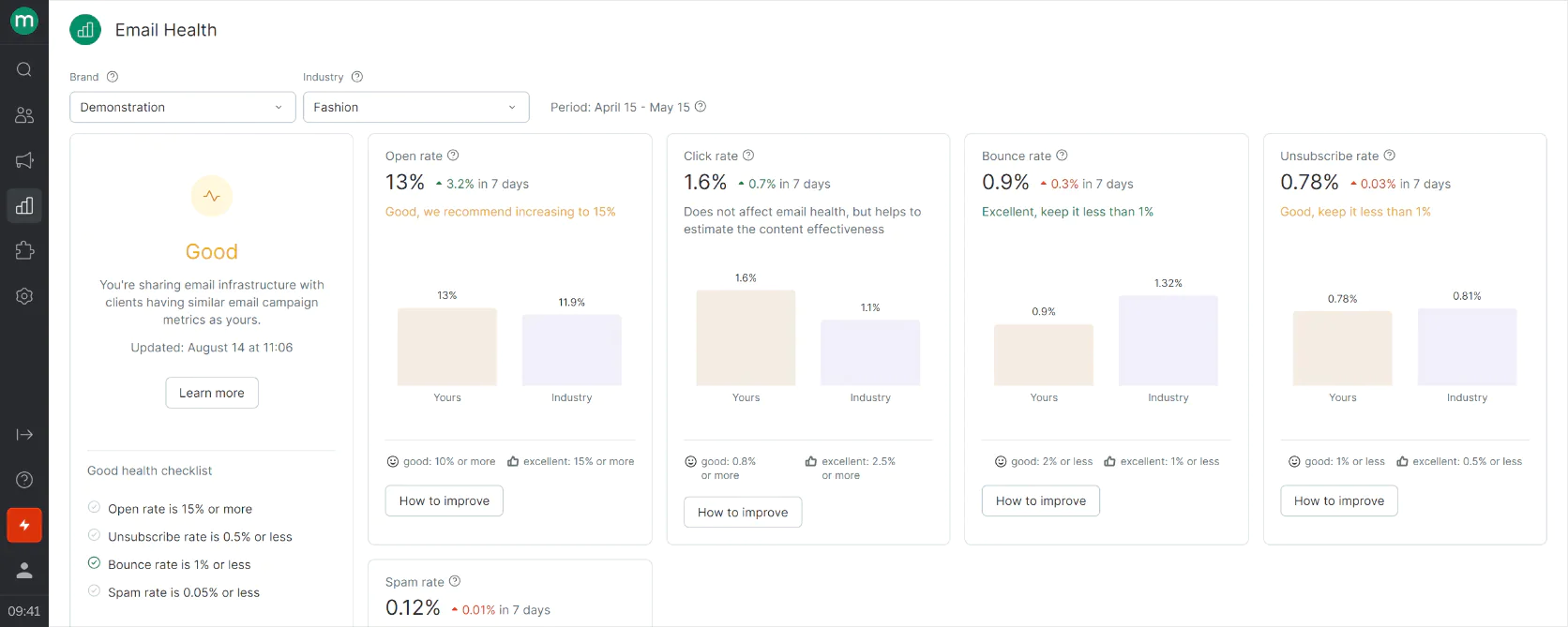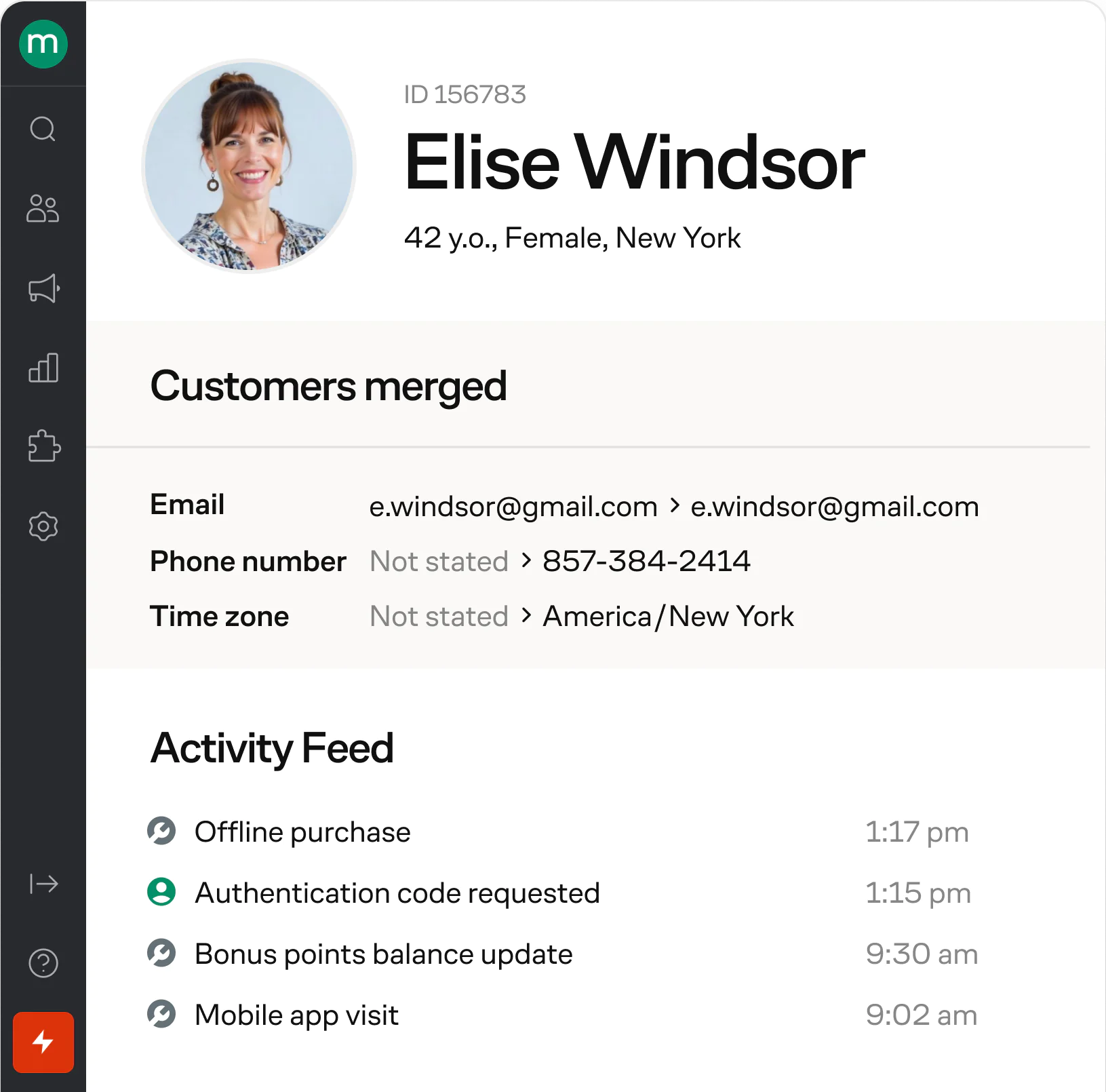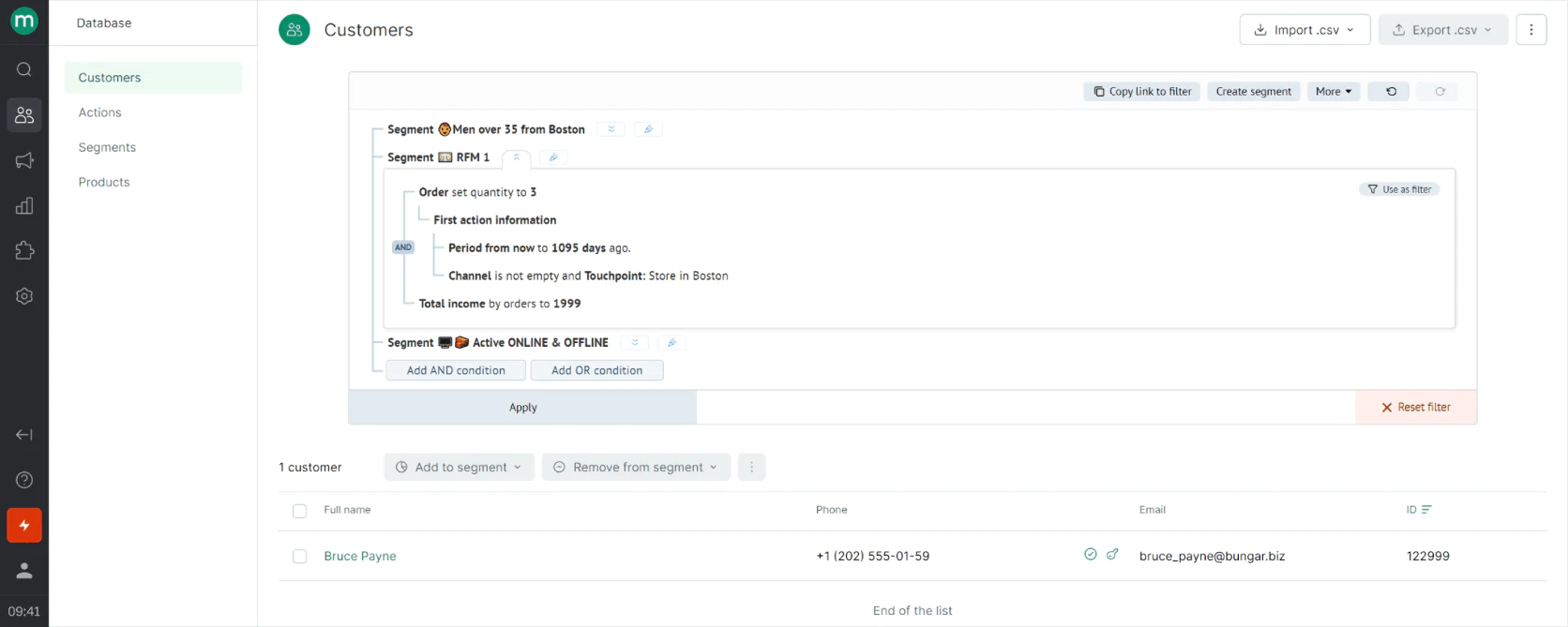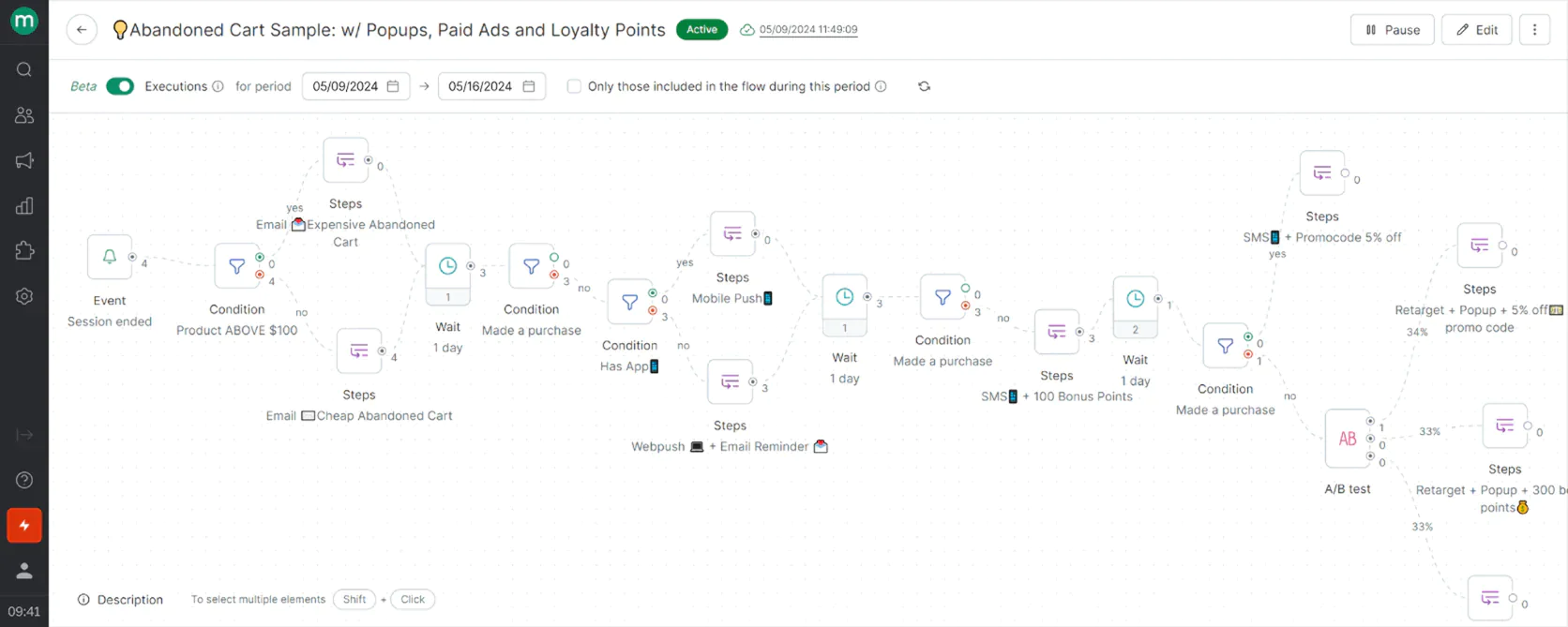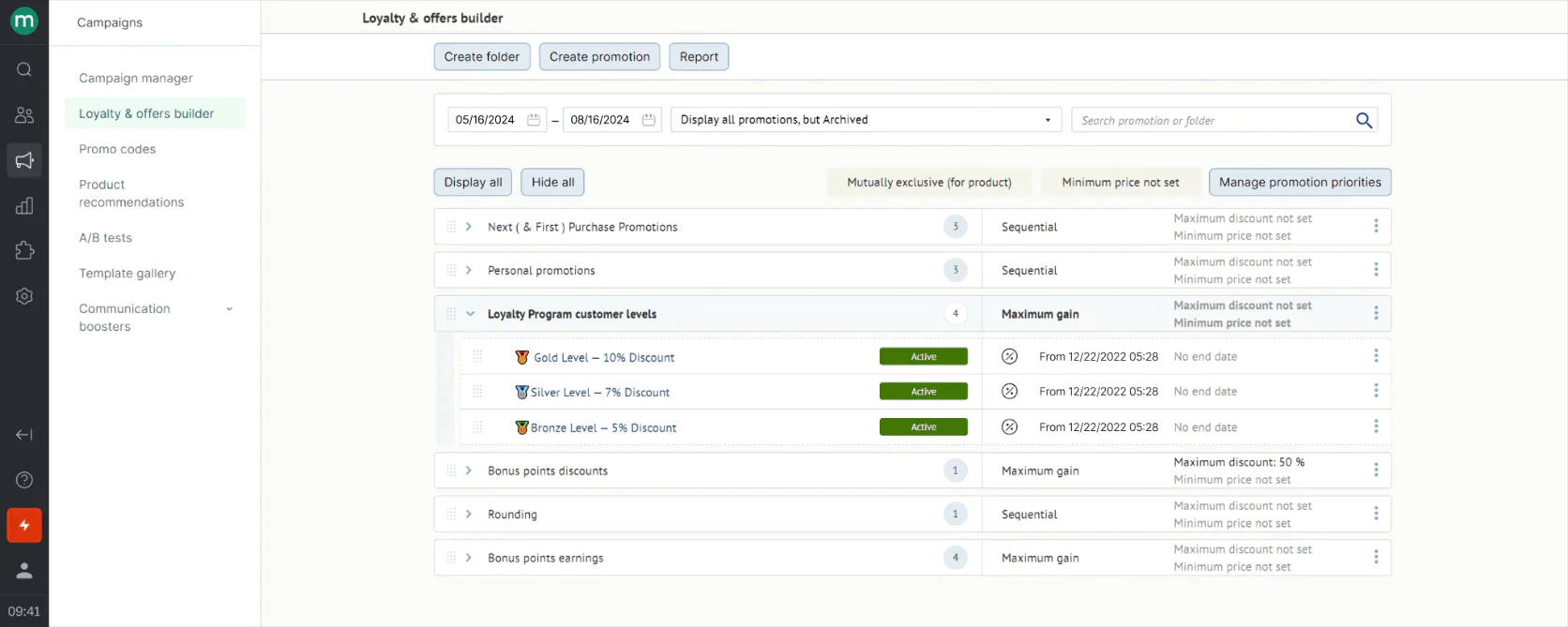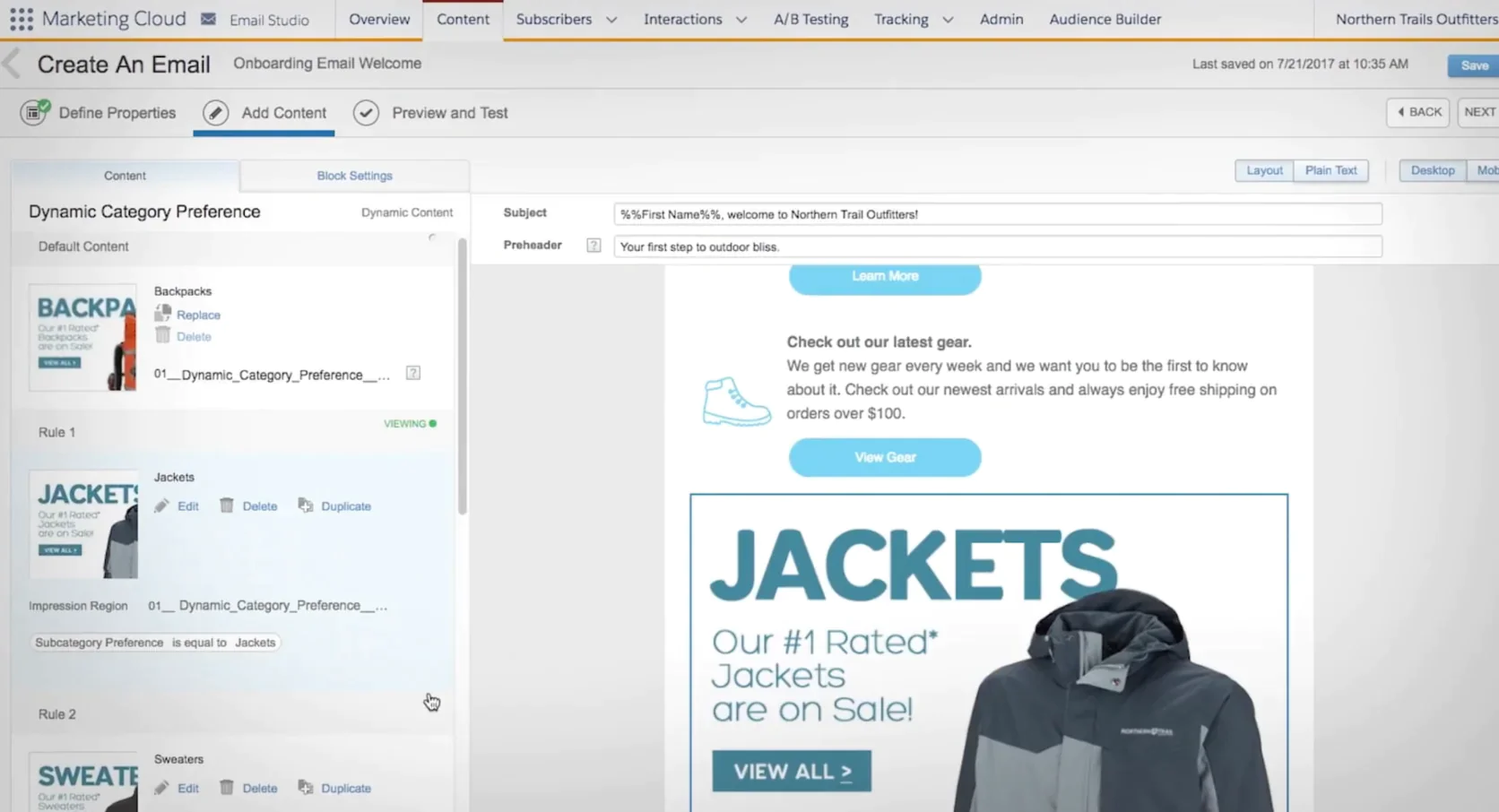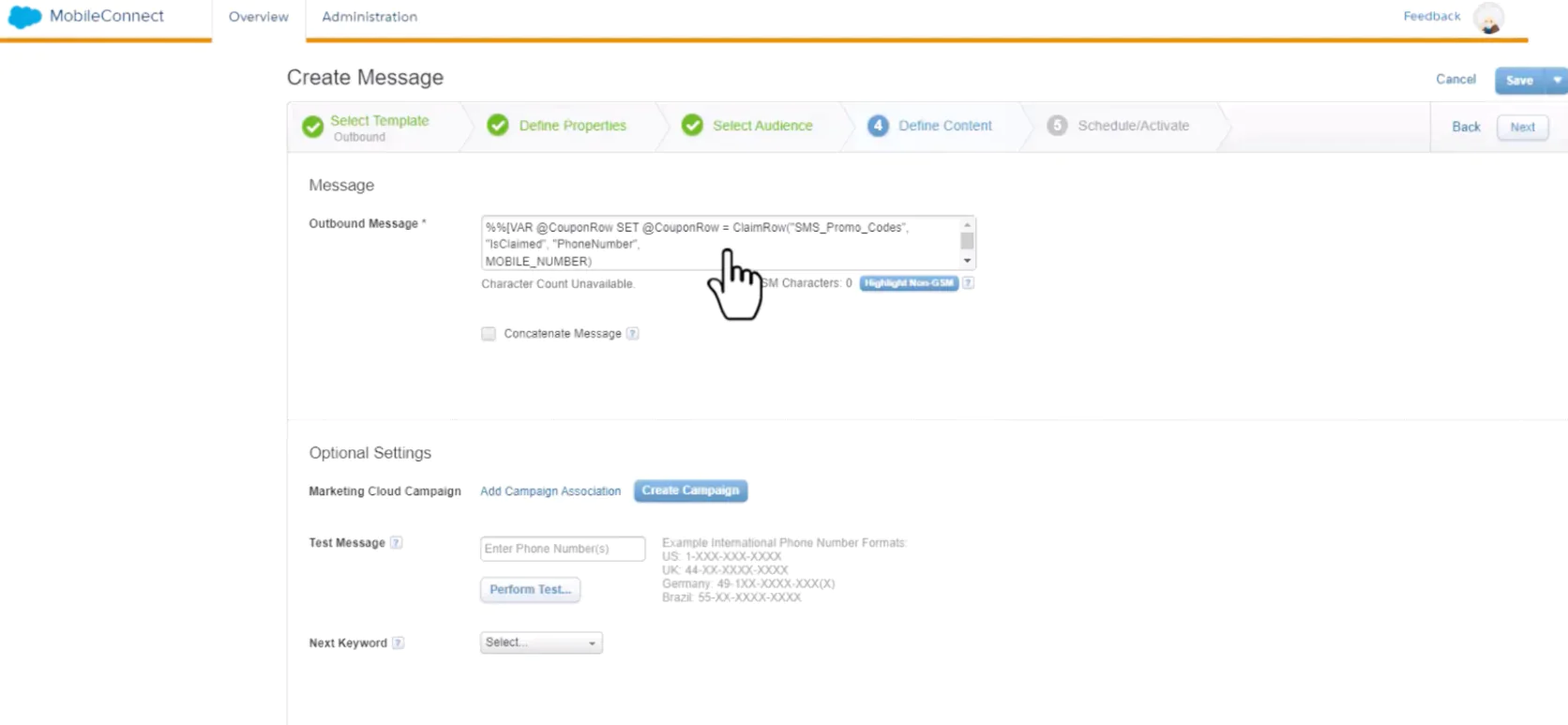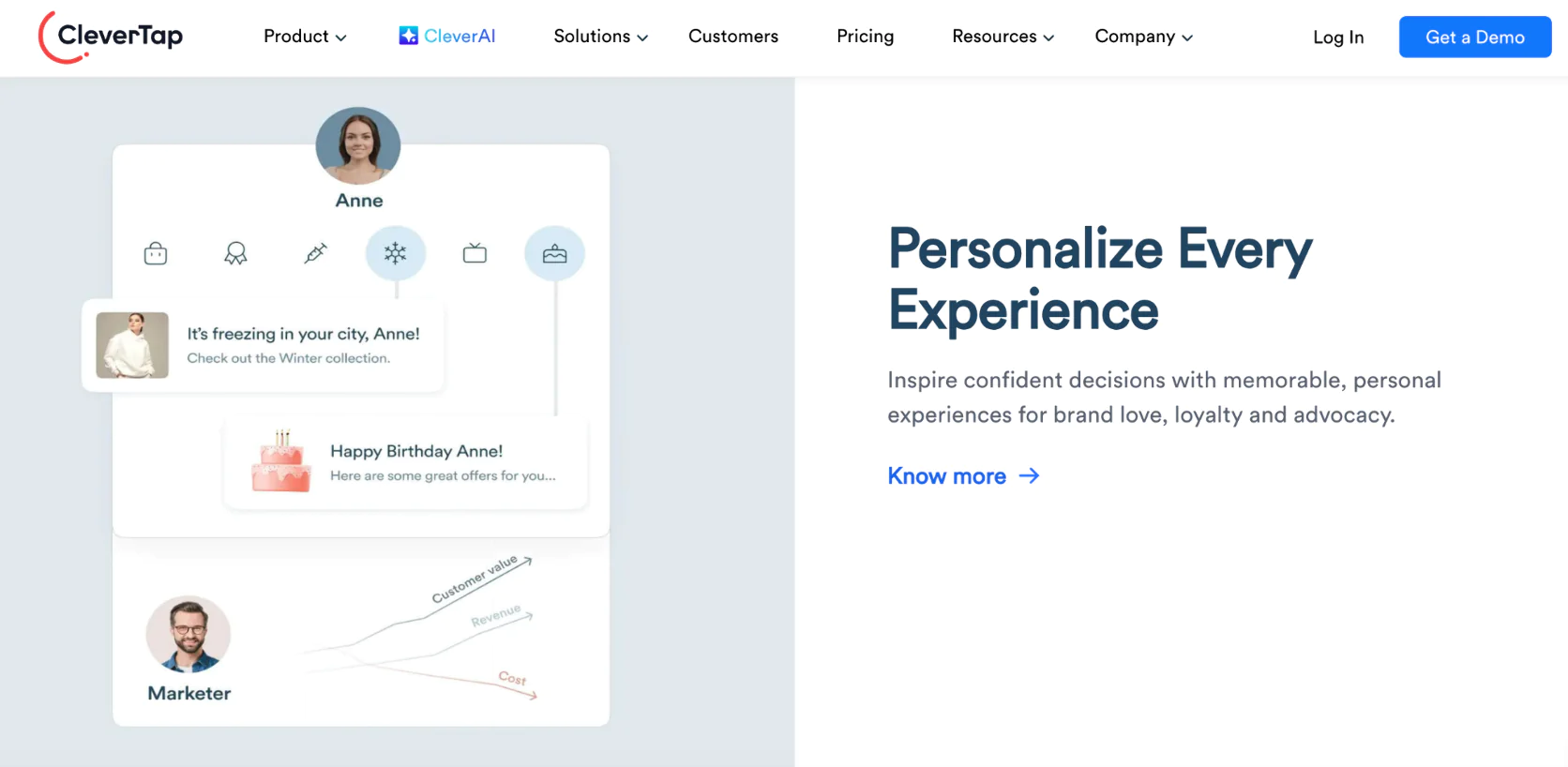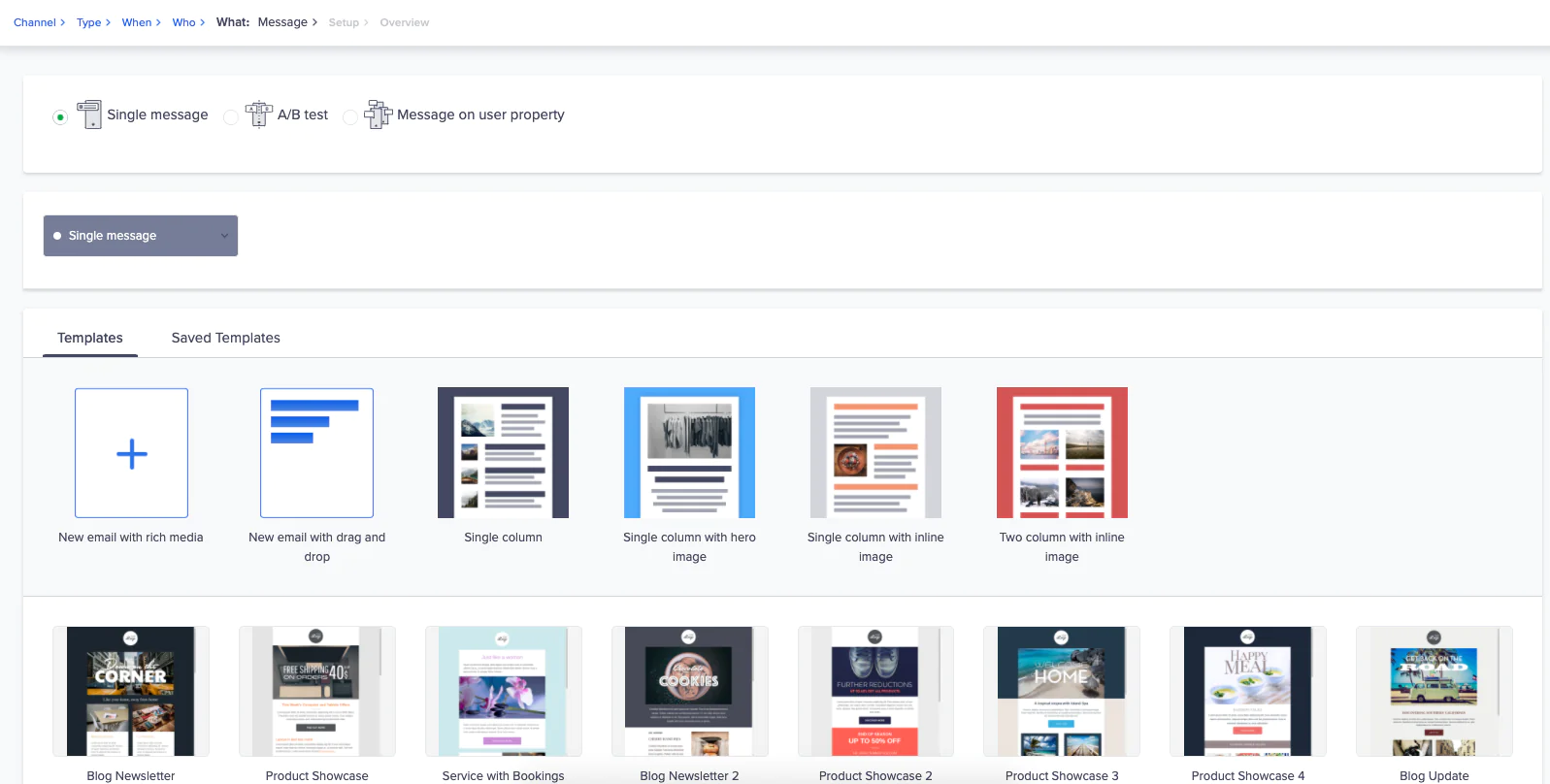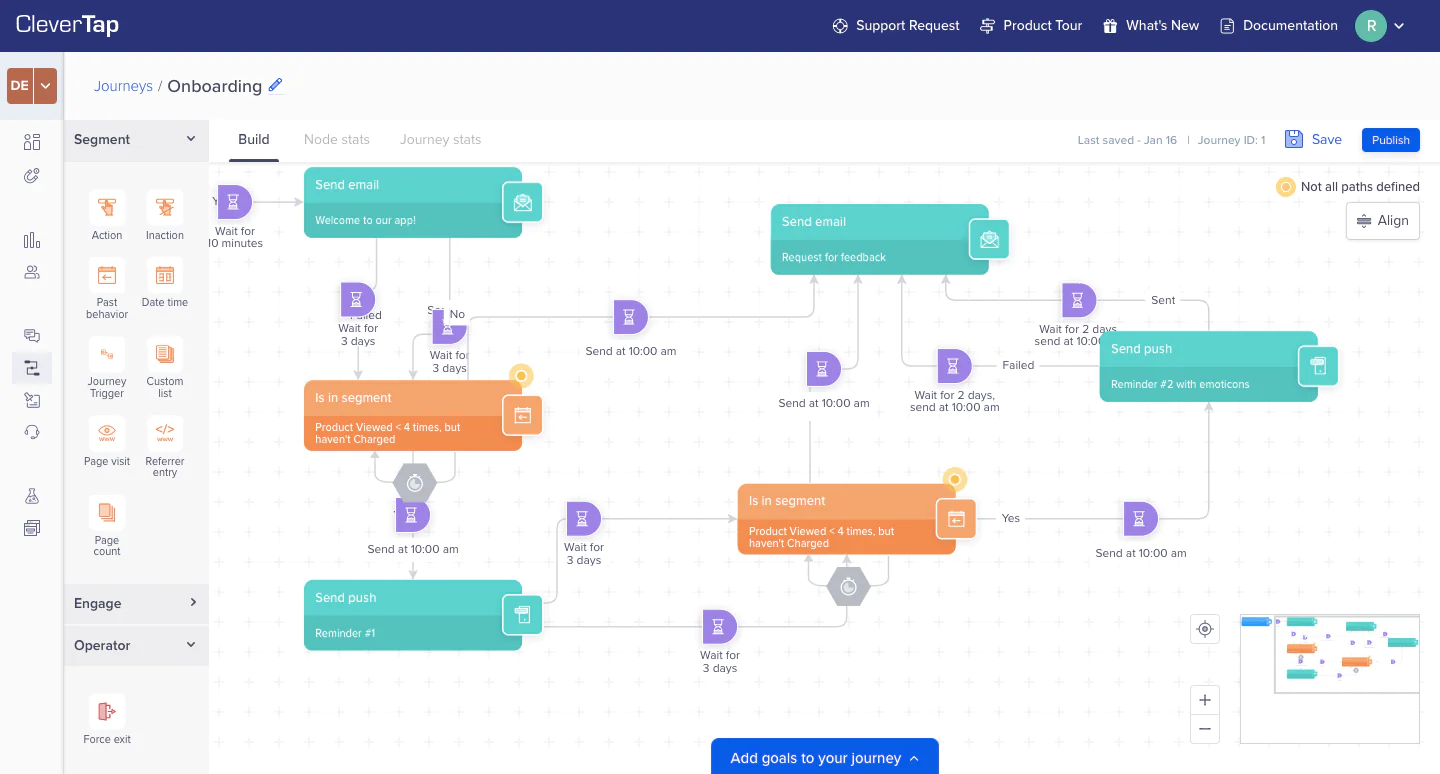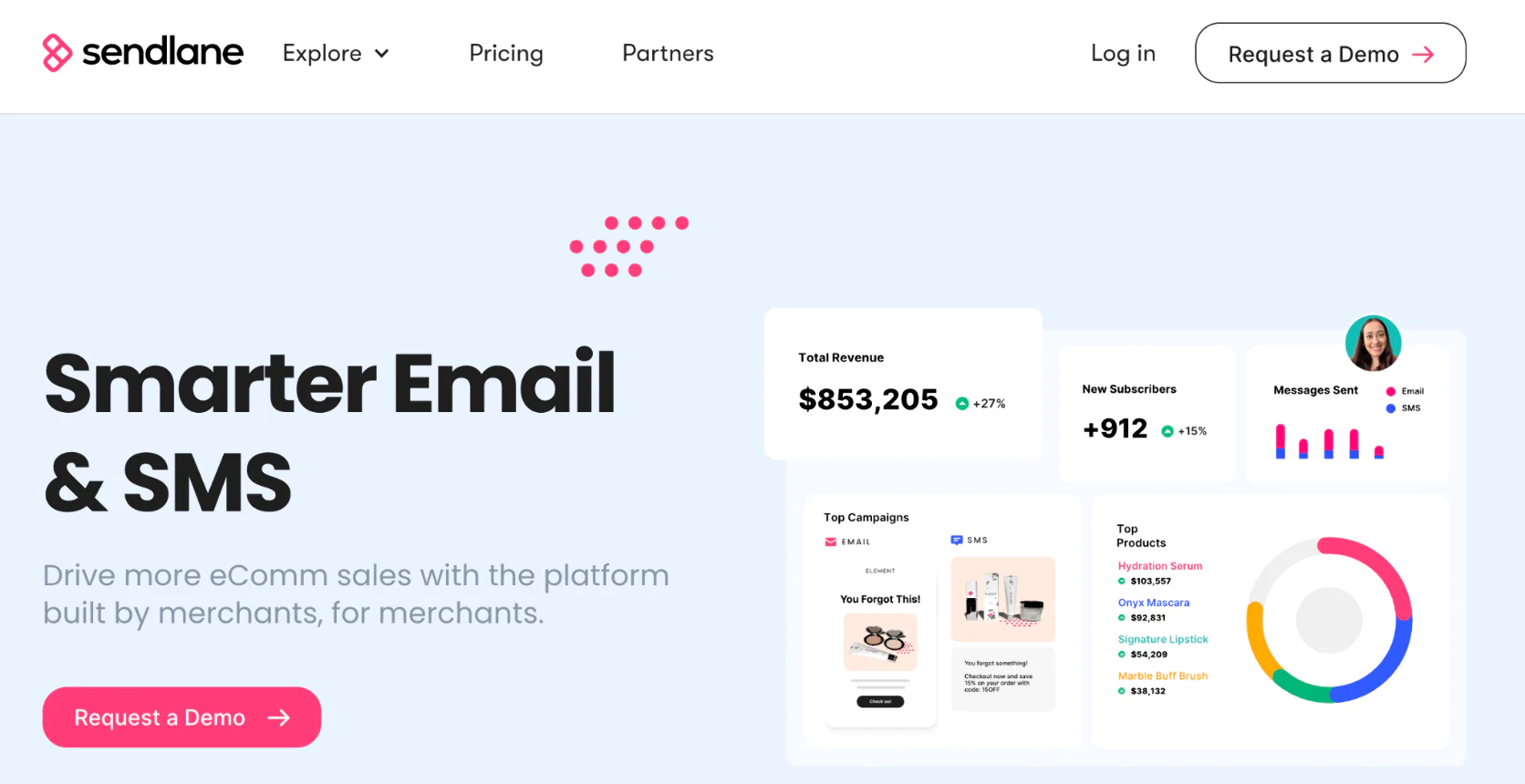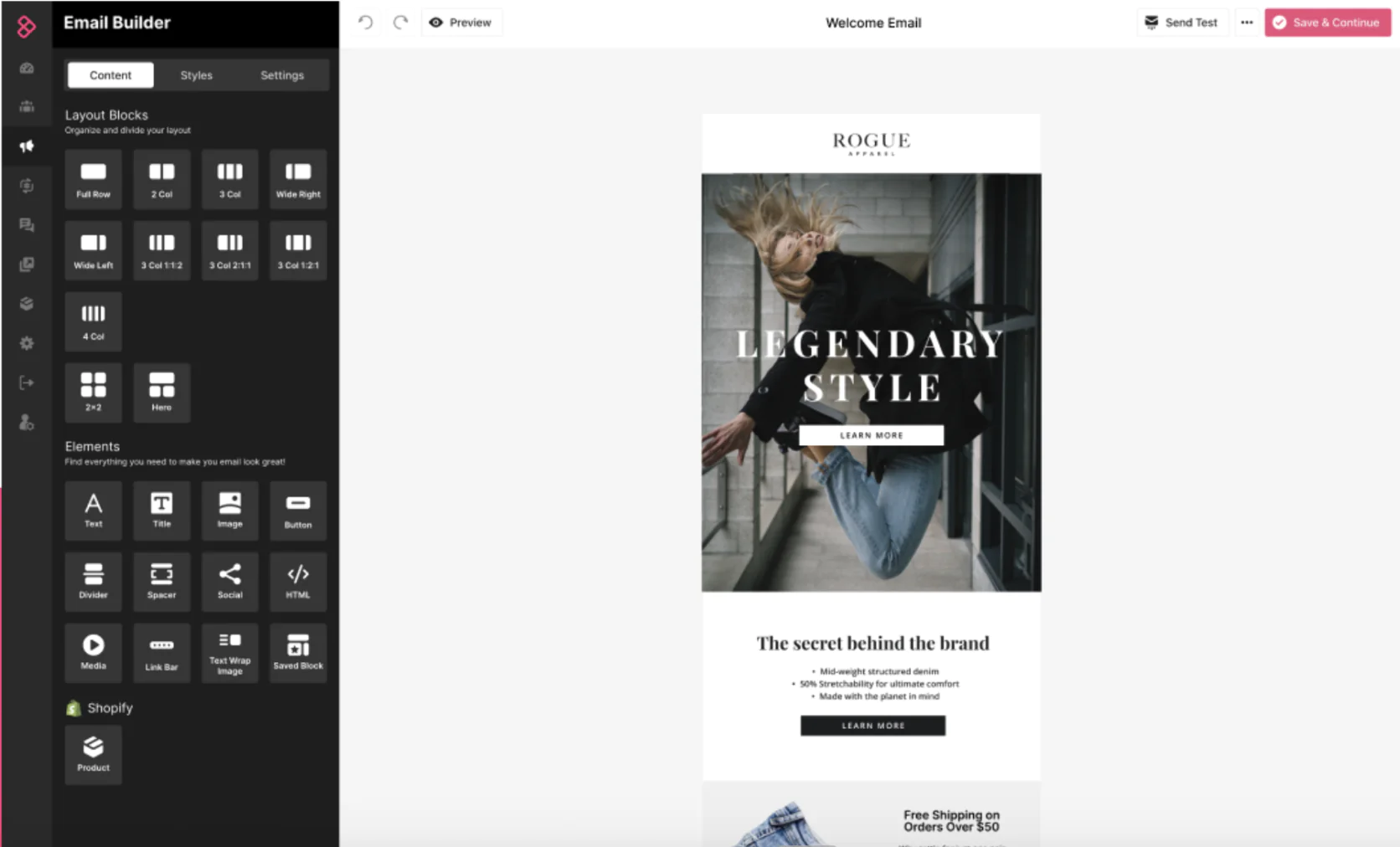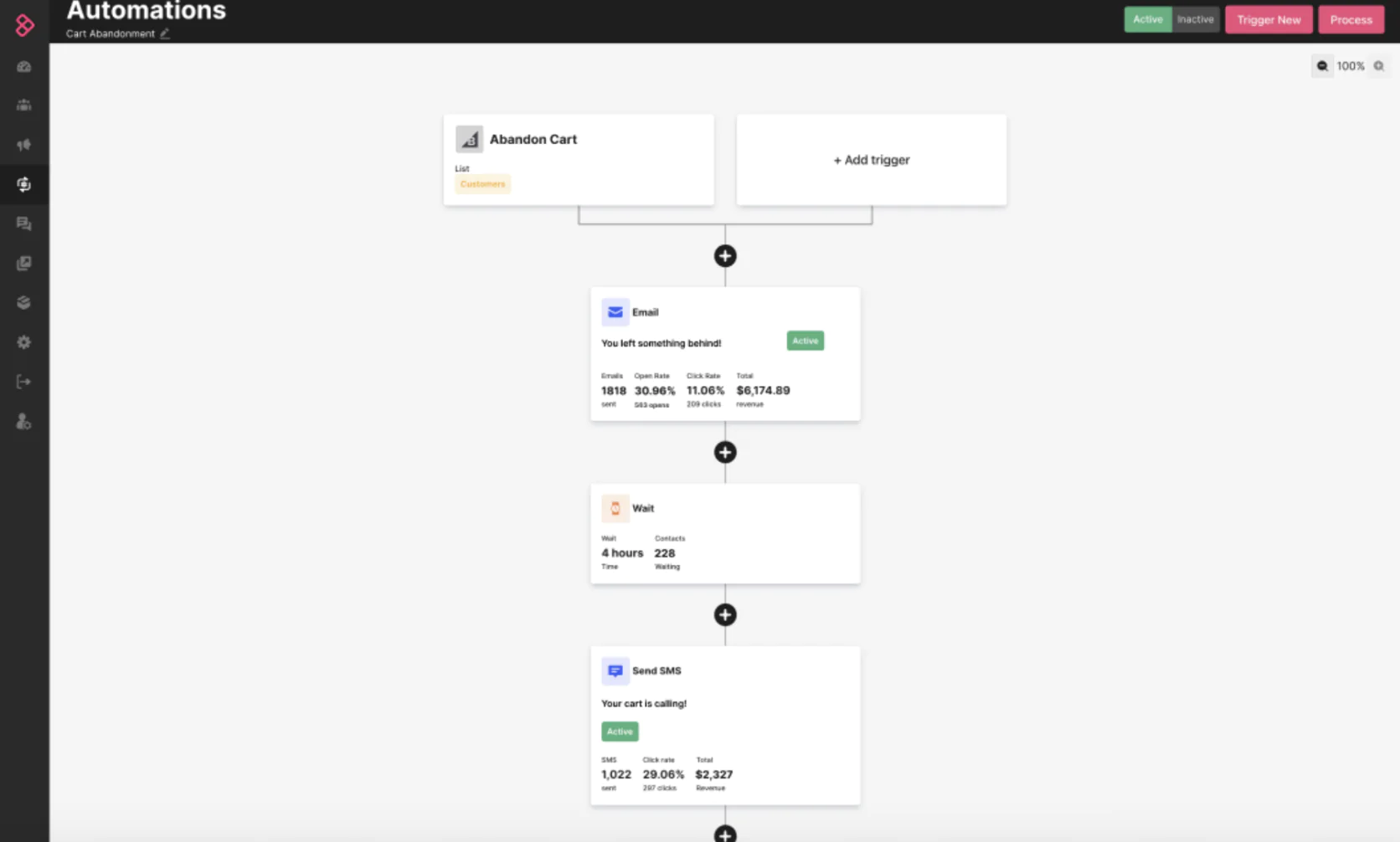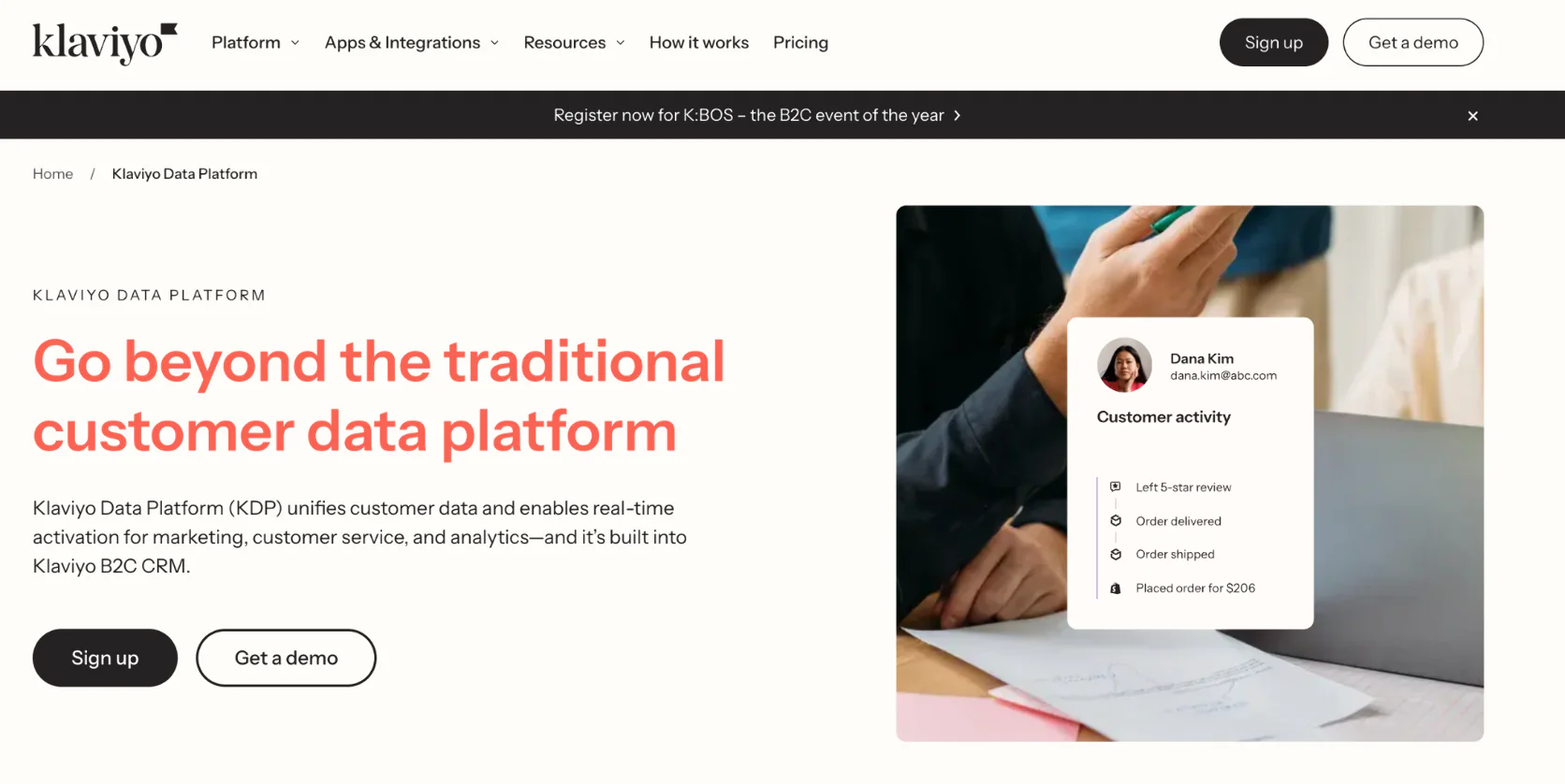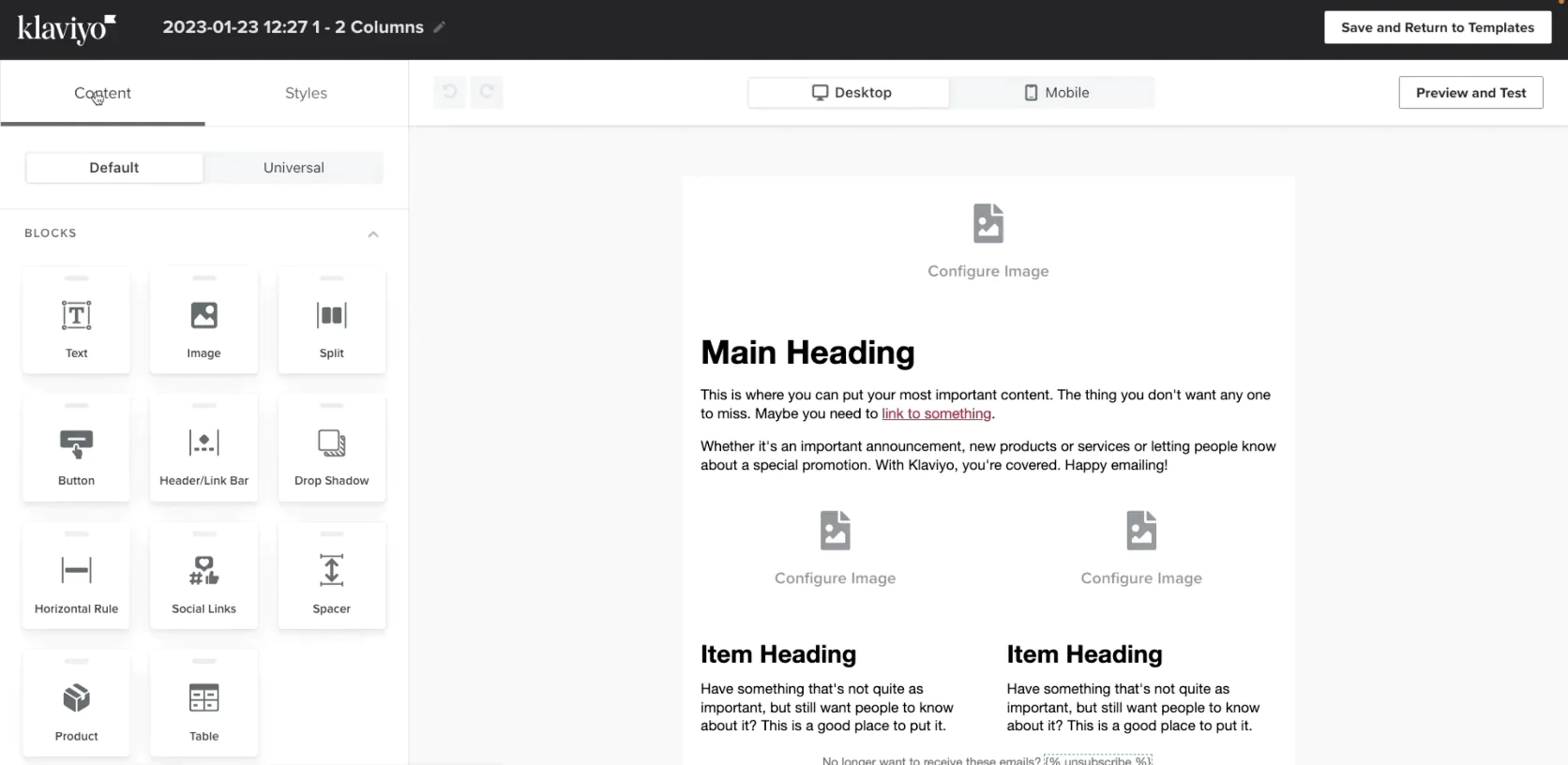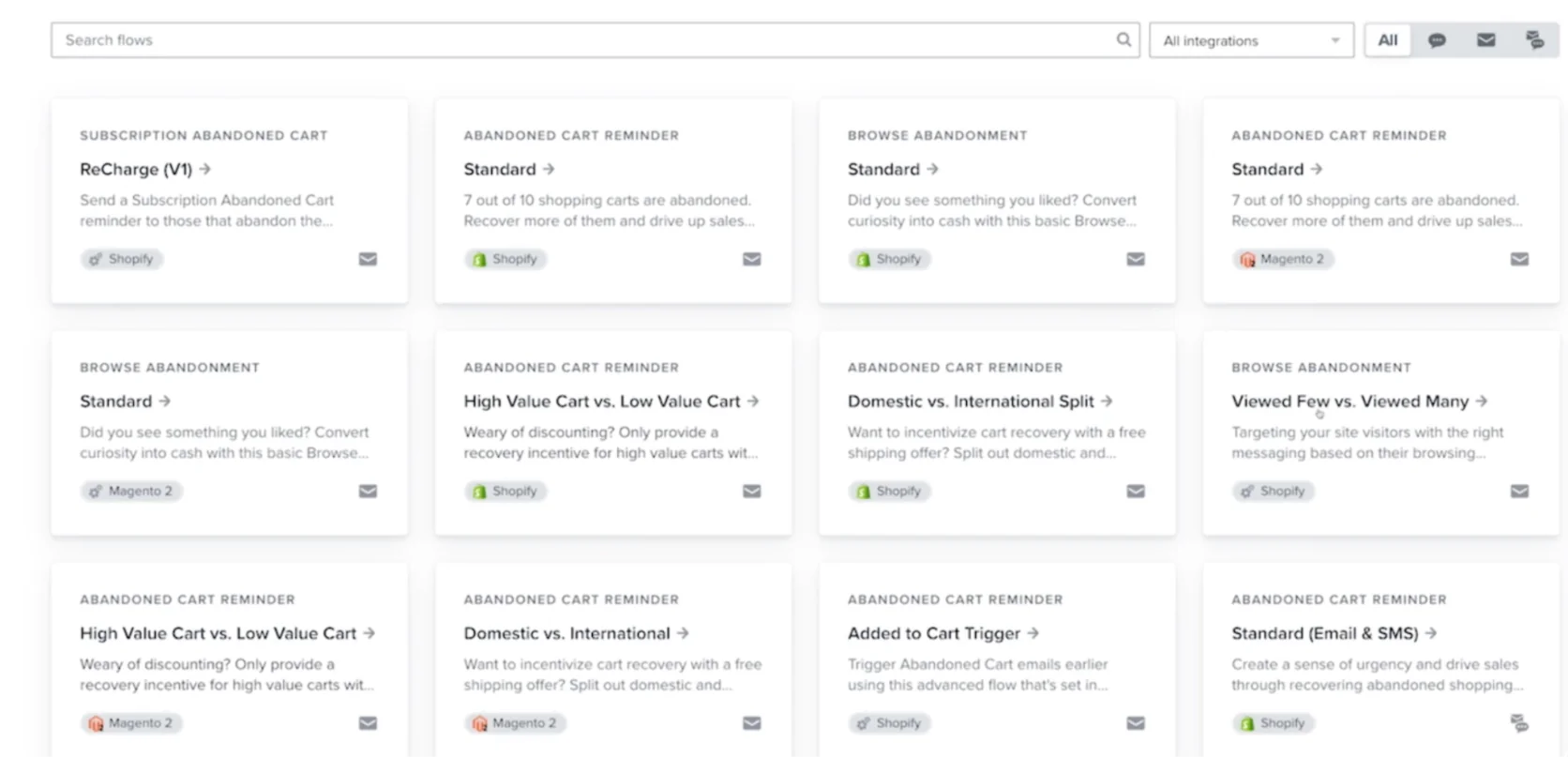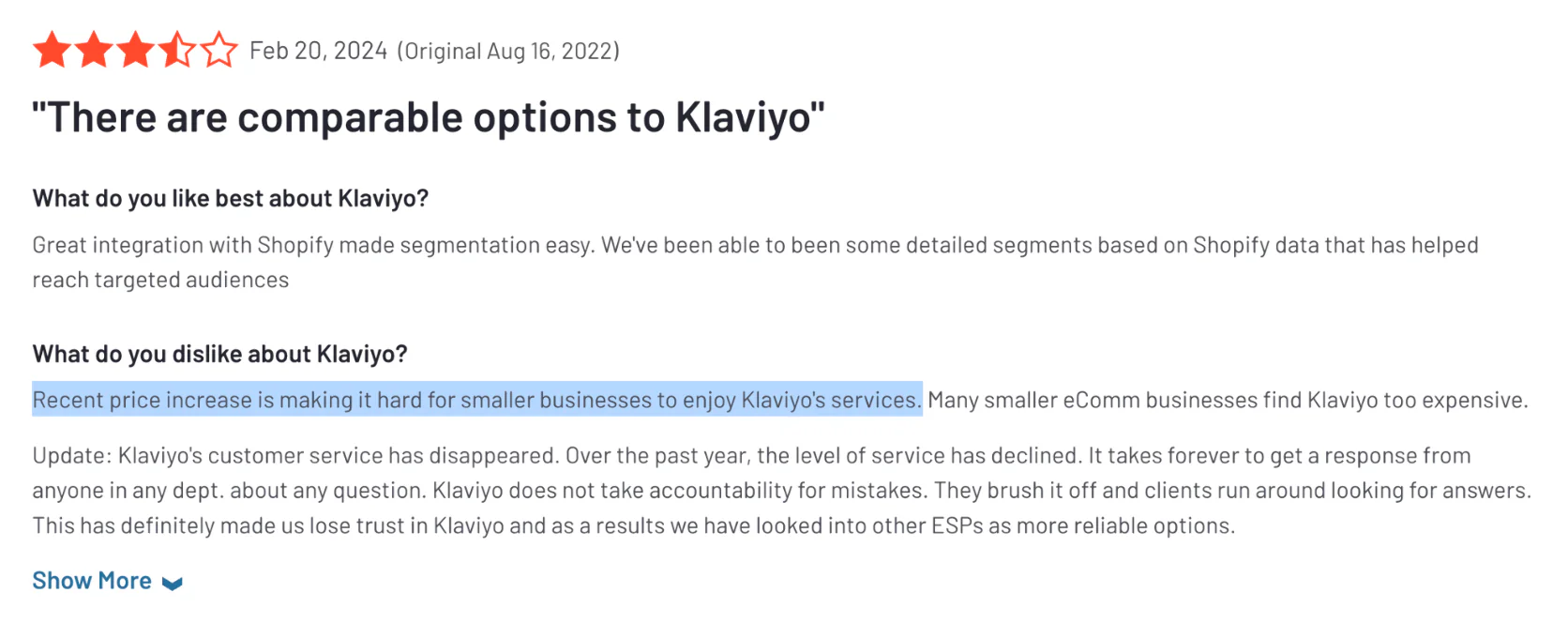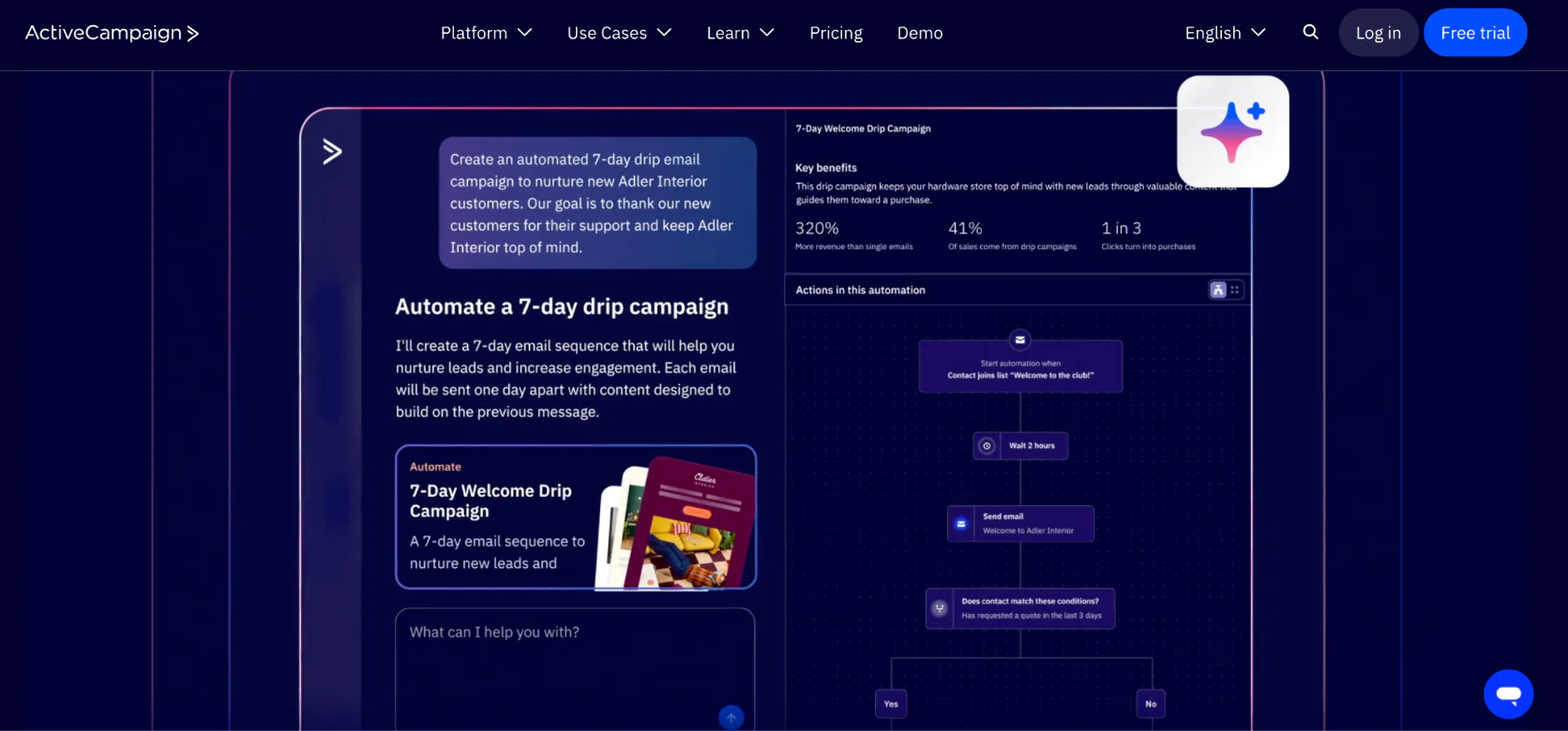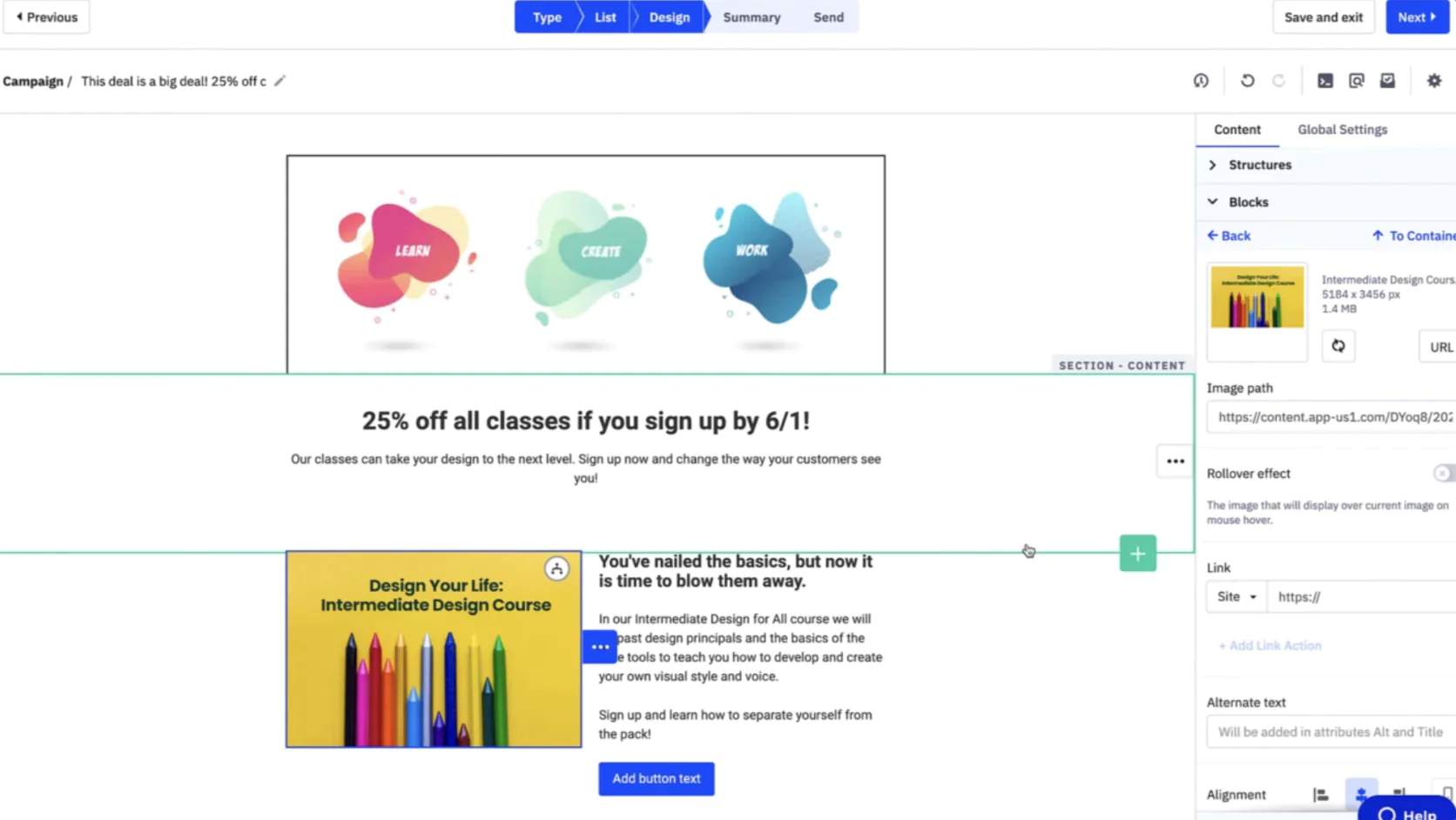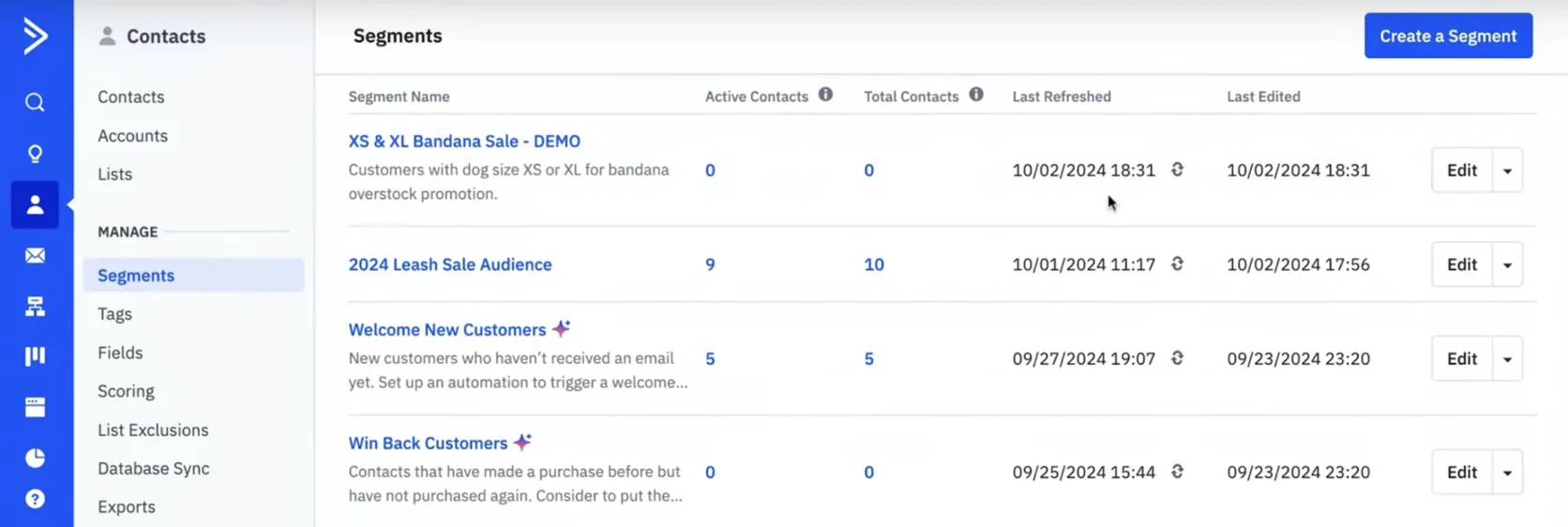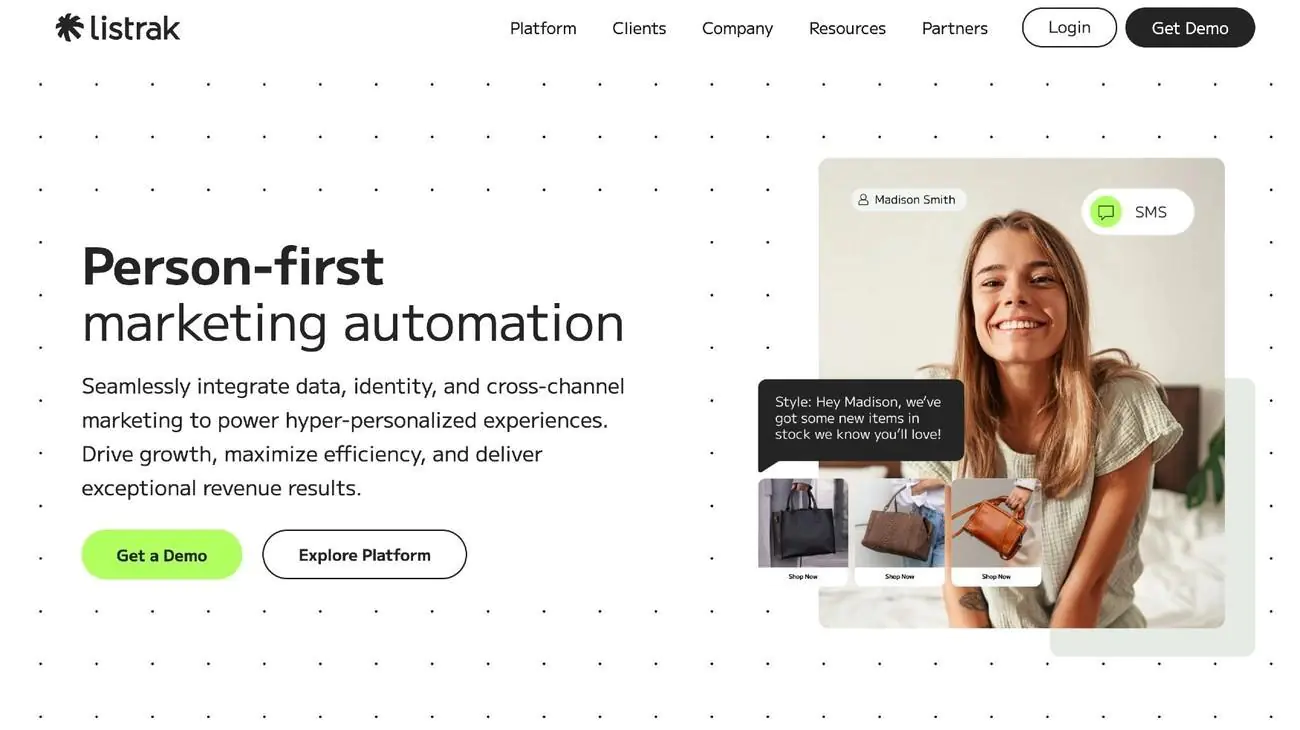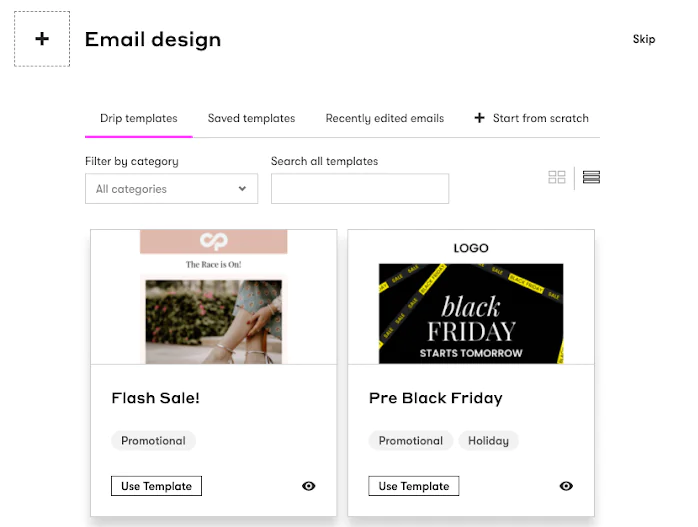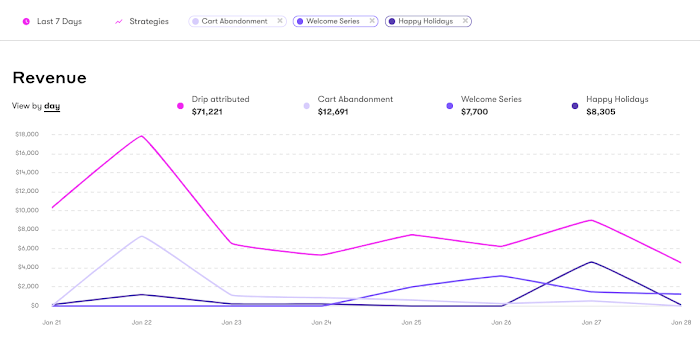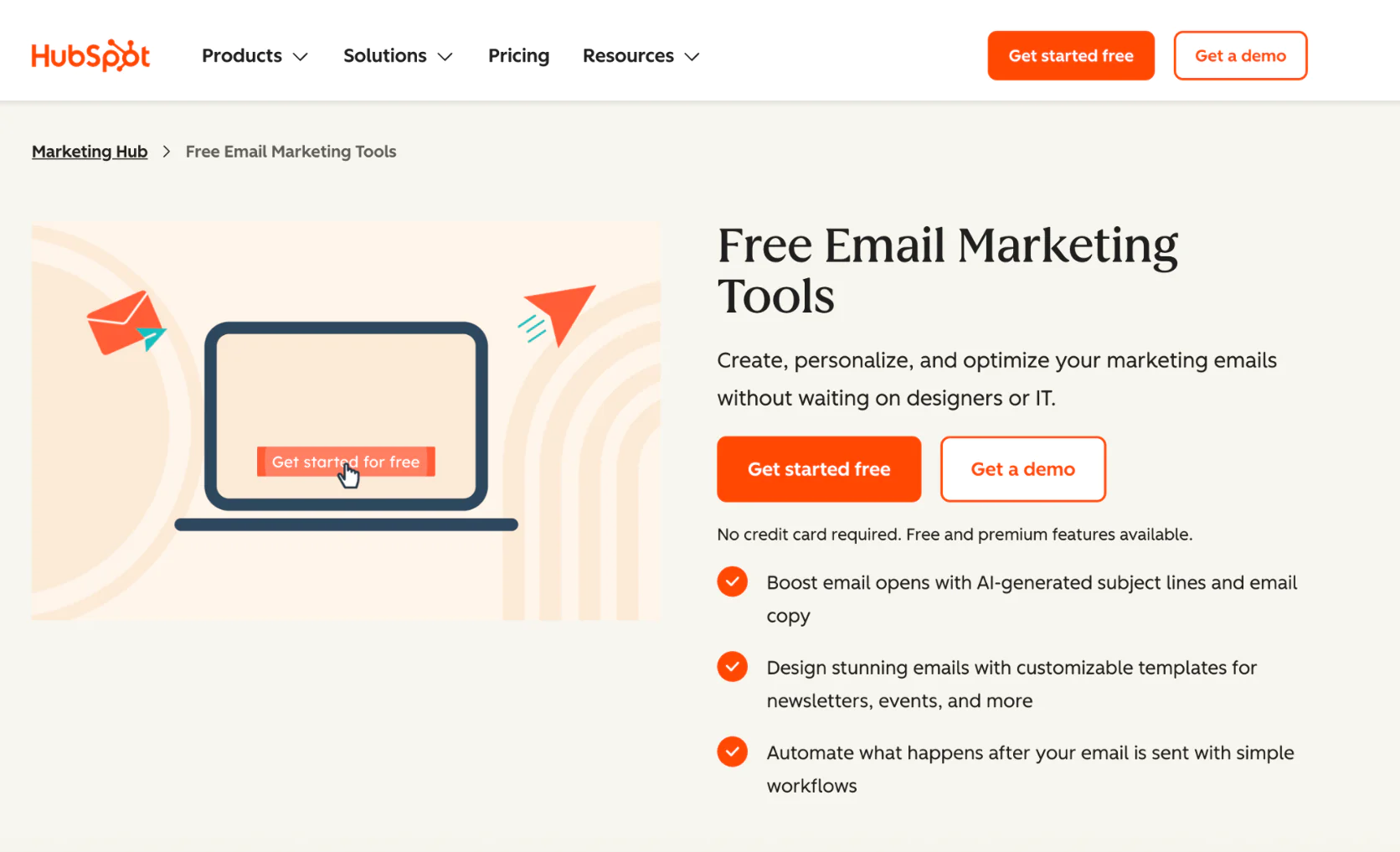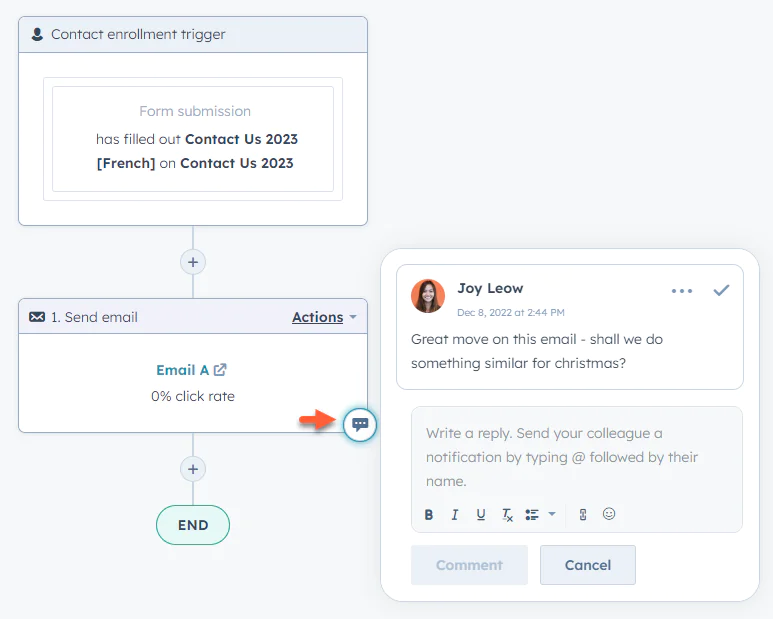Top Email Marketing Platforms That Boost E-commerce Sales in 2025
Email marketing platforms generate $42 for every dollar spent, making them the highest ROI digital channel in 2025.
Your choice of platform can substantially affect your e-commerce success. The right platform drives conversions through customized campaigns and efficient workflows.
To choose an email marketing automation platform, businesses need to assess essential features, including user-friendly email editors, advanced segmentation capabilities, and reliable automation tools. Modern platforms now blend email with SMS marketing, loyalty programs, website and app personalization to create multi-channel campaigns that boost customer involvement.
This piece looks at ten leading solutions. Starting with Maestra, we analyze Salesforce Marketing Cloud, CleverTap, Sendlane, and Klaviyo. Each analysis covers their editors, segmentation tools, automation features, capabilities, support options, pricing, and core advantages.
Combined Email Marketing Platform Comparison Table
Maestra
Drag-and-drop + HTML editor, advanced personalization, AMP support, code efficiency
Real-time CDP, granular targeting, nested segmentation, computed fields
Cross-channel (email, SMS, messenger, paid ads) , real-time response, advanced workflows
Omnichannel automation, built-in loyalty and referral engine, website and app personalization
Dedicated CSM for all tiers, free migration services, weekly calls
From $2,990/
month (transparent pricing)
Salesforce Marketing Cloud
Content Builder with AI integration, complex dynamic content
CRM-based, complex rules, sales pipeline integration
Journey Builder, multi-step campaigns, AI boost
Deep Salesforce CRM integration, powerful segmentation, highly extensible ecosystem
Varies by tier, often requires consultants
~$1,500 –$3,250/
month (mid-tier)
CleverTap
Mobile-optimized, no-code interface
AI-driven behavioral analysis, event-based
Visual journey builder, cross-channel orchestration
Immediate user behavior database (TesseractDB)
Tiered support, migration assistance
From $75/
month (5k MAUs)
Sendlane
Drag-and-drop + HTML, e-commerce templates
Behavioral targeting, purchase patterns
E-commerce focused flows, event triggers
Landing pages and forms
High-touch, Strategic guidance, dedicated onboarding
Starts at 5,000 contacts
Klaviyo
Product-focused, dynamic content, drag-and-drop
Unified customer view, behavior-based
Pre-built flows, visual builder
Easy integration with e-commerce platforms, SMS integration
Tier-based, Limited for lower plans
Free to start; $20-30/month (500 contacts)
Active Campaign
Drag-and-drop + HTML editor with responsive templates and dynamic content blocks
Purchase history, website behavior, engagement metrics and custom fields
Visual builder with multi-step paths and e-commerce specific workflows
CRM integration, site tracking, SMS marketing and predictive sending
Email, live chat, knowledge base and community forums
$29/month (1,000 contacts)
Listrak
Retail-focused editor with product integration and responsive design
RFM analysis, product preferences, lifecycle stage and inventory tracking
Retail-focused workflows with immediate behavior triggers
Ppredictive analytics and cross-channel orchestration
Personal account manager, 24/7 emergency support and expert guidance
~$1,000/ month
Drip
Commerce-centric editor with product showcase blocks and dynamic content
Purchase patterns, product preferences, lifecycle stage and behavioral tags
E-commerce specific workflows with visual canvas and split testing
SMS integration and lead scoring
Email, live chat, knowledge base and webinars
$39/month (500 contacts)
HubSpot Marketing Hub
Drag-and-drop + HTML editor with responsive templates and CMS integration
Contact properties, website interactions, email engagement and form submissions
Multi-channel workflows with visual builder and branching logic
Landing pages, CRM, social media tools and content management
Support varies by plan with knowledge base, community and email/chat
$45/month (Starter)
Omnisend
Drag-and-drop editor with commerce-centric blocks and product feed integration
Shopping behavior, purchase history, campaign engagement and lifecycle stage
E-commerce conversion paths with multi-channel workflows
Cross-channel marketing, product suggestions, pop-ups and campaign booster
Email support, knowledge base and webinars
Free (250 contacts), $16/month (Standard)
Maestra stands out in email marketing as an all-in-one marketing platform built for e-commerce brands that want to combine their marketing tech stack.
The platform brings together omnichannel marketing automation, strong customer data infrastructure, website and app personalization, product recommendations, and complete loyalty management in one solution. This helps brands avoid using multiple specialized tools.
The platform's drag and drop email composer shines through its technical excellence. It uses lean code that prevents message clipping – a common problem with bigger emails. This smart coding helps emails look great on all devices and email clients.
Maestra’s visual email composer
The editor lets marketers create dynamic content for specific customer groups using Maestra's CDP data.Maestra stays ahead with modern email tech like AMP emails that add interactive elements right in the messages.
The platform also makes sure emails land in inboxes instead of spam folders. Marketing teams love this mix of creative freedom and solid performance.
Maestra’s email health monitoring
Maestra's real-time Customer Data Platform (CDP) sits at its heart. It creates complete customer profiles from both online and offline data.
Customer profile in Maestra
Unlike simple segmentation tools, Maestra lets you target customers based on specific details – from single page visits to exact purchase history. Marketing teams can then run highly targeted campaigns based on exact customer actions and priorities.
User segmentation in Maestra
The CDP handles complex data better than simpler platforms like Klaviyo. This makes it perfect for businesses that need advanced segmentation. Teams can create super-targeted campaigns that respond to customer actions right away, which leads to better customer experiences.
The platform does much more than just send email sequences. Marketers can coordinate full campaigns across email, SMS, web notifications, and mobile channels from one dashboard. A customer’s trip might start with an email, switch to an SMS if they don’t respond, and show them a custom banner when they visit the website again.
Maestra’s flow example: abandoned card flow with emails, mobile and web pushes, pop-ups, paid ads and loyalty points
These workflows react to what customers do in real-time rather than following a fixed schedule. This makes messages feel more natural and timely compared to basic drip campaigns that just follow a set timeline.
Maestra Extended Features
Maestra has features you'd usually need separate platforms for. A complete loyalty and rewards program lets brands give points, VIP status tiers, and referral rewards – all without extra loyalty software. Having everything in one system keeps customer data unified.
Maestra’s promotions rule engine
The platform also has tools for website personalization, including product suggestions and custom web content.
Maestra’s pop-up template editing
These built-in features remove the need for extra tools that would scatter customer data across different systems:
Real-time CDP: Built-in Customer Data Platform with AI-powered segmentation that unifies customer data from all touchpoints including email opens, call center calls, and offline purchases.
SMS Marketing: Platform supports SMS messaging at $0.0045 per message, creating coordinated multi-channel campaigns reaching customers on their preferred devices.
Site Personalization: Real-time website personalization with pop-ups, quizzes, surveys, games, embedded blocks, stories, widgets, banners, and bars that adapt instantly to customer behavior.
Product Recommendations: AI-driven recommendation engine with 14 algorithms that personalizes product suggestions in real-time based on browsing history and customer preferences.
Loyalty Programs: Integrated loyalty system with real-time point tracking, bonus rewards, and automated incentives that respond to customer actions without third-party tools.
Mobile Push Notifications: SDK for mobile apps enables real-time push notifications and personalization directly integrated with customer data and behavior tracking.
Paid Media Optimization: Automated exclusion of recent buyers from paid campaigns and dynamic audience targeting based on real-time customer segments and behavior.
Maestra takes a hands-on approach to customer support. Every client gets their own Customer Success Manager (CSM), no matter which plan they choose. They are always in touch in a shared Slack channel and meet every week for a strategic session.
Moreover, CSM handles all the heavy lifting: migration and integration, rebuilding and improving flows, email design, and so on.
Growing brands find this personal guidance valuable when they need a strategic partner, not just software access. This advisory approach sets Maestra apart from platforms that just offer tech support.
Plans start at $2,990 monthly with full feature access. All the same, this pricing might give better value than competitors like Braze. The flat rate includes everything instead of charging extra for different features. When you think about the cost of separate tools Maestra replaces (loyalty programs, personalization engines, etc.), many businesses might actually save money.
Salesforce Marketing Cloud (SFMC) stands as a major player in enterprise marketing. The platform comes with a complete suite of tools that blend smoothly with the broader Salesforce ecosystem. The platform evolved from ExactTarget and works best for organizations that already use Salesforce CRM, giving them unified customer data across sales and marketing.
Salesforce Marketing Cloud Email Editor
SFMC's email creation tools match its enterprise-level status. The platform gives marketers the ability to create sophisticated email campaigns through Content Builder. This tool combines drag-and-drop features with code-level access. SFMC is different from simpler platforms because it lets users customize deeply and create complex dynamic content rules based on customer data in Salesforce CRM.
Salesforce Marketing Cloud’s email builder
The editor goes beyond simple personalization by using Einstein AI to recommend content and optimize send times.
The platform's powerful features come with a trade-off – new users might need technical help for complex tasks because the interface isn't as accessible as newer alternatives.
Salesforce Marketing Cloud Segmentation
SFMC's connection with Salesforce CRM makes it exceptional at handling data. Marketers can utilize detailed customer profiles that include purchase history, support interactions, and sales touchpoints. The platform's segmentation goes way beyond simple demographics or email engagement metrics.
Salesforce Marketing Cloud: user segmentation
Users can directly use CRM objects in segmentation rules. This means campaigns can target customers based on their sales pipeline position or service history. A retail business could automatically identify high-value customers who recently had support issues and create specialized recovery campaigns – all without moving data between systems manually.
Salesforce Marketing Cloud Automations
Journey Builder powers SFMC’s automation features with a visual canvas for creating multi-step customer campaigns across channels. The tool handles complex decision splits, wait times, and cross-channel coordination better than basic automation tools.
Salesforce Marketing Cloud flow builder
The platform excels at scheduled campaign journeys but works differently from Braze's real-time, event-driven campaigns. SFMC works great for "batch and blast" campaigns while supporting triggered message sequences.
Einstein AI makes these journeys even better with predictive features like conversion likelihood scoring and abandonment predictions.
Salesforce Marketing Cloud Extended Features
SFMC's broad ecosystem makes it stand out from focused platforms. The suite includes:
Social media management
Mobile push notification capabilities
SMS marketing
Advanced analytics and attribution modeling
Creating a message in Salesforce Marketing Cloud
The Salesforce AppExchange offers many extensions for specific needs, from custom SMS integrations to analytics plugins. The platform comes ready with enterprise features like IP warming, distributed marketing for franchises, and compliance tools for regulated industries.
Salesforce Marketing Cloud Support
SFMC's complexity means businesses often need specialized expertise – a key factor in total ownership cost. Many companies hire certified SFMC consultants or specialists to get the most value. Implementation takes longer and needs more resources than simpler alternatives.
Support options change based on contract level. Premium support packages give faster responses and dedicated technical resources. New implementations usually need professional services to ensure proper setup.
Salesforce Marketing Cloud Cost
SFMC's premium pricing puts it squarely in the enterprise category. Mid-tier packages cost between $1,500 and $3,250 monthly. Full-featured setups cost even more.
The platform uses annual contracts instead of monthly subscriptions, with prices based on contacts, message volume, and active features.
SFMC costs about the same as alternatives like Braze for similar features. The real cost often ends up higher than just platform fees because of specialized staff needs and possible consulting expenses.
Salesforce Marketing Cloud Pros and Cons
Seamless Salesforce CRM integration showing all customer interactions
Hard to learn and needs specialized expertise
Large ecosystem with many extensions and integrations
Complex interface that's less accessible than modern alternatives
Powerful Journey Builder for complex multi-channel campaigns
High total cost including platform, personnel, and consulting
Strong data handling and customization options
Enterprise-grade deliverability and compliance features
CleverTap is a customer engagement and retention platform that captures detailed behavioral data. The platform helps companies boost retention and lifetime value through sophisticated user event tracking and AI-driven campaign orchestration.
Unlike platforms that focus mainly on email, CleverTap's email editor is just one part of its broader mobile-centered engagement toolkit. The editor follows a simple approach that lets marketers create messages without technical knowledge. The platform's mobile background ensures email templates work well on all devices.
The editor connects to CleverTap's user behavior database and personalizes content based on detailed app interaction histories rather than just demographic data or simple email metrics.
Creating an email with Clever.AI’s recommendations
CleverTap's advanced segmentation powered by
Clever.AI technology stands at its core. The platform analyzes complex user behaviors to predict outcomes like churn probability and conversion likelihood.
TesseractDB sets CleverTap apart – a specialized big-data store that captures millions of individual user events. This technology lets marketers create segments based on specific app interactions instead of broad customer categories. Product teams find this detail valuable to understand precise user behavior patterns in mobile applications.
The visual journey builder makes shared cross-channel campaign orchestration possible. Marketers can design sequences that start with an in-app message, send an email if unopened, and trigger a push notification based on user responses.
The platform now supports customer experiences across multiple touchpoints, building on its mobile-centric foundation. Marketing teams can implement complex behavioral triggers without much technical support through the easy-to-use automation interface.
CleverTap Extended Features
CleverTap has complete omnichannel capabilities. These span push notifications, in-app messages, email, SMS, web notifications, and WhatsApp integration.
The platform offers robust A/B testing tools that optimize campaigns through analytical insights. The AI engine analyzes user priorities and behaviors to suggest relevant products or content.
Mobile app developers get detailed analytics dashboards showing retention metrics, conversion funnels, and user engagement patterns.
The support structure balances enterprise solutions and simpler tools. Support tiers match pricing packages, and higher tiers get more individual attention. Teams can access complete documentation and an educational knowledge base for best practices.
CleverTap provides setup help during onboarding to ensure proper tracking and data flow configuration.
The pricing follows a tiered structure. The Essentials plan starts at $75/month for up to 5,000 Monthly Active Users (MAUs). Prices increase with user counts, and higher tiers need custom quotes. Growing companies can start small and scale up as needed.
The pricing reflects the platform's specialized nature between simple email tools and enterprise-level engagement platforms like Braze.
Powerful AI-driven segmentation and predictive modeling
Less focused on e-commerce than platforms like Maestra
Up-to-the-minute user behavior database handling millions of events
Complex analytics capabilities take time to master
Outstanding mobile app analytics and engagement capabilities
Web capabilities lag behind mobile features
Complete omnichannel reach including push, in-app, email, and SMS
Sendlane stands out as an email and SMS marketing platform that serves direct-to-consumer (DTC) brands with powerful capabilities and outstanding customer support. E-commerce businesses choose this platform because it provides hands-on guidance with strong marketing tools.
The email editor strikes a perfect balance between functionality and simplicity. Users can choose between drag-and-drop features and HTML customization options. E-commerce businesses will find responsive templates that showcase products and promotional content effectively.
The platform shows detailed ROI statistics for every email, which helps marketers track revenue from individual messages. DTC brands find this feature valuable for conversion tracking.
The platform's
behavioral targeting works based on website activity, purchase history, and email engagement. Marketers can create segments that match specific customer experiences and purchase patterns. This feature lets them develop targeted campaigns for different groups like first-time buyers, repeat customers, or browse abandoners.
Segmentation leads to higher conversion rates and serves as the foundation of Sendlane's e-commerce strategy.
Automation workflows designed for e-commerce conversion and retention are at the heart of Sendlane's offering. Users get pre-built flows for standard sequences such as abandoned carts and welcome series.
The platform supports complex event-based triggers too. Marketers can create automations based on specific customer actions without complex technical setup.
The visual flow builder makes campaign orchestration smooth across email and SMS channels.
Sendlane Extended Features
Sendlane goes beyond basic features. Its retargeting capabilities help brands connect with customers through multiple touchpoints.
Users can create landing pages and forms just like in more expensive platforms, making it a more detailed solution than basic email providers.
Customer support sets Sendlane apart from competitors. Each account gets dedicated onboarding help to set up properly and match strategy goals. Support teams provide more than technical help – they offer strategic advice to optimize campaigns and boost revenue.
Growing brands that need both powerful tools and expert guidance to maximize email marketing returns will find this approach valuable.
The platform uses a contact-based pricing model starting at 5,000 contacts. While the entry point is higher than some competitors, each tier comes with unlimited emails. Costs increase with contact volume and SMS usage, which means businesses pay according to their growth. Small businesses might find it a substantial investment initially, but it becomes more affordable as customer lists grow.
Strong deliverability focus that ensures messages reach subscribers
Higher entry cost than basic email platforms
Simple event-based triggers that need minimal technical setup
Mobile app capabilities lag behind mobile-first platforms like CleverTap
Detailed revenue tracking for each email
Fewer built-in advanced features than all-in-one solutions like Maestra
Outstanding dedicated customer support with strategic guidance
Klaviyo stands out as a specialized solution among email marketing platforms for e-commerce businesses of all sizes. This 5-year-old platform has gained popularity with direct-to-consumer brands by connecting commerce data to marketing campaigns.
The platform's email creation tools serve online retailers well. You'll find drag-and-drop features and templates that showcase products effectively.
The editor shines when it displays dynamic product feeds and individual-specific recommendations based on shopping patterns. Marketers can show items that match past purchases or browsing history to boost conversion rates.
Both beginners and advanced users will appreciate the platform's range from simple campaigns to complex dynamic content.
Klaviyo's true power lies in its segmentation engine. The platform creates detailed targeting based on what customers buy, browse, and how they interact.
Creating a segment in Klaviyo
Unlike simple list tools, it builds a complete picture of each customer by tracking website visits, email engagement, and purchases. You can create specific groups like "bought Product A but not Product B" or "looked at category X three times without buying." This focus on behavior makes messages more relevant than just using demographic data.
The platform's pre-built automation flows help you run welcome series, abandoned cart reminders, and win-back campaigns. Its visual builder lets you create message sequences that work across email and SMS channels.
Flow templates in Klaviyo
Messages trigger based on customer actions, which drives sales effectively. Marketing teams don't need technical skills to run sophisticated automation campaigns.
Klaviyo Extended Features
The platform blends SMS marketing with email capabilities for coordinated campaigns.
One-click connections to Shopify, Magento, and WooCommerce make data flow smooth without complex setup. You also get predictive analytics to spot high-value customers and prevent churn.
Each plan tier offers different support levels. The company changed its policy to give live chat only to higher-paying customers. Small clients now use email support or documentation. Users on basic plans report about slower responses during busy campaign periods.
New businesses can start with a free tier. Paid plans begin at $20-$30 monthly for 500 contacts and scale up with your subscriber count. No long-term contracts are needed. Large contact lists can make the service expensive, which affects ROI calculations as businesses grow.
Quick integration with e-commerce platforms
Basic plans have limited support
Strong behavior-based segmentation
Higher costs for larger lists
No built-in loyalty program or web personalization
Flexible pricing for growing businesses
Channel options limited to email and SMS
ActiveCampaign stands out among top email marketing platforms for e-commerce businesses that want to improve customer involvement and boost sales. The platform goes beyond simple email marketing with its detailed feature set and automation focus.
ActiveCampaign Email Editor
The platform offers a versatile email editor that combines functionality with simplicity. The drag-and-drop interface helps create responsive emails without coding knowledge. Advanced users can exercise more control through the HTML editor.
ActiveCampaign’s email composer
The editor has many pre-designed templates optimized for e-commerce. These include abandoned cart reminders, product recommendations, and seasonal promotions. The platform's dynamic content blocks adjust automatically based on customer data. This feature enables individual-specific messaging at scale.
The platform sets itself apart from competitors by offering extensive design flexibility. Users retain full control while ensuring mobile responsiveness in all email creations.
ActiveCampaign Segmentation
The platform excels with its advanced segmentation capabilities. E-commerce businesses can create targeted customer segments based on several data points:
Purchase history and buying patterns
Website browsing behavior
Email engagement metrics
Custom fields and tags
Geographic and demographic information
The segmentation engine updates lists dynamically as customer behaviors change. Merchants can move customers automatically between different segments based on their actions. This creates more relevant and timely communications.
The platform's segmentation capabilities offer more detailed targeting compared to simple email marketing tools. This precision guides users toward higher conversion rates for e-commerce campaigns.
ActiveCampaign’s segments
ActiveCampaign Automations
The visual automation builder helps users create complex, multi-step customer experiences across channels.
E-commerce businesses can access several pre-built automation templates:
Abandoned cart recovery sequences
Post-purchase follow-ups and cross-sell opportunities
Customer win-back campaigns for lapsed buyers
Product review requests and loyalty program communications
Each automation supports conditional logic, action-based splits, and timing delays. Businesses can create individual-specific customer experiences that activate at the right moment.
The platform combines smoothly with your e-commerce system. Messages trigger based on specific product purchases, price changes, or inventory updates. This makes it valuable for online retailers.
ActiveCampaign Extended Features
The platform offers several features beyond core email marketing that add value for e-commerce businesses:
CRM Integration: The built-in CRM system tracks customer interactions across channels. Sales teams get valuable context for individual-specific follow-ups.
SMS Marketing: The platform supports SMS messaging alongside email. This creates coordinated multi-channel campaigns reaching customers on their preferred devices.
Predictive Sending: AI capabilities determine the best sending times for individual contacts based on past engagement.
The platform provides multi-tiered support options by plan level. All customers can access:
Email support
Live chat during business hours
A detailed knowledge base
Community forums
Higher-tier plans come with dedicated onboarding, priority support, and sometimes a dedicated account representative. Regular webinars and training sessions focus on e-commerce marketing strategies.
The support system works well for most mid-market e-commerce businesses, though it lacks the 24/7 support of some enterprise alternatives.
The platform uses a tiered pricing structure based on contact count and feature access. The 2025 pricing tiers include:
Lite: Starting around $29/month for 1,000 contacts
Plus: Starting around $49/month for 1,000 contacts
Professional: Starting around $149/month for 1,000 contacts
Enterprise: Custom pricing
The platform costs more than simple email marketing tools. However, its pricing remains competitive given its advanced automation capabilities and e-commerce-specific features.
ActiveCampaign pros and cons
Advanced automation workflows perfect for e-commerce customer experiences
Takes more time to learn than simple email platforms
Precise segmentation for targeted campaigns
Higher costs as contact lists grow
Solid integration with major e-commerce platforms
Advanced features need higher-tier plans
Detailed reporting on campaign performance and ROI
No built-in loyalty program management
Combined email and SMS channel communications
Limited mobile app functionality compared to desktop
Flexible pricing that adapts to your business growth
Listrak provides a complete solution that helps e-commerce businesses boost their email marketing strategies in 2025. This specialized platform combines powerful email features with advanced consumer insights to create personalized shopping experiences for online retailers.
Listrak’s email editor excels with its retailer-focused approach to content creation. Users get a simple drag-and-drop interface alongside HTML editing options that work well for marketers at all technical skill levels.
The editor comes with a rich library of e-commerce-specific templates that showcase products effectively. Dynamic product recommendation blocks update automatically based on customer's priorities and shopping behavior. The editor supports responsive design elements that display emails correctly on all devices – a significant feature since mobile devices now account for over 60% of email opens.
Listrak's editor sets itself apart through seamless product data integration. Merchants pull current inventory, pricing, and imagery directly from their e-commerce store into email templates. This ensures accurate and current product information in every campaign.
Listrak's audience targeting capabilities shine with sophisticated segmentation tools built for retail operations. The system analyzes explicit data like purchase history and customer priorities along with implicit signals such as browsing behavior and email engagement to create specific customer segments.
The platform lets merchants segment based on:
Purchase recency, frequency, and monetary value (RFM analysis)
Product category affinities
Lifecycle stage (new customer, repeat purchaser, at-risk)
Email engagement metrics
Geographic location and other demographic factors
Listrak's automation capabilities focus on the e-commerce customer's trip. The platform goes beyond standard triggered emails to enable complex automation workflows across different customer touchpoints.
The platform creates sophisticated, multi-step workflows for:
Cart abandonment recovery sequences (with multiple touchpoints)
Post-purchase follow-ups and replenishment reminders
Customer reactivation campaigns for lapsed buyers
The automation engine responds to real-time behavior triggers instantly. The system sends personalized product recommendations when shoppers view specific categories but leave without purchasing.
Listrak Extended Features
Listrak's value extends beyond core email functionality with several additional features for online retailers:
SMS Marketing Integration: The platform coordinates messaging across email and text channels from one interface. This multi-channel approach creates more complete customer engagement strategies.
Predictive Analytics: Machine learning algorithms analyze customer data to predict future behaviors. This helps merchants identify at-risk customers or high-value acquisition targets.
Cross-Channel Orchestration: The platform coordinates email campaigns, SMS messaging, and on-site personalization instead of focusing solely on email.
Listrak stands out with its emphasis on customer support and strategic guidance. Each client works with a dedicated Strategic Account Manager who provides ongoing campaign optimization advice and industry best practices.
Direct phone and email support
24/7 emergency assistance
Regular account reviews and strategy sessions
Extensive knowledge base and resource library
Quarterly business reviews with performance analysis
Mid-sized retailers without large internal marketing teams benefit from this high-touch approach to client services. The support structure provides expertise alongside technological solutions.
Listrak uses a tiered pricing structure based on email volume and required features in 2025. While custom quotes determine specific pricing, typical entry points start at:
Simple tier: Approximately $1,000/month (email marketing essentials)
Advanced tier: $2,000-$3,000/month
Enterprise tier: $3,500+ (full omnichannel capabilities with dedicated strategic services)
The platform positions itself as a premium solution compared to entry-level email platforms. Growing e-commerce businesses can access advanced features at these price points. Strategic services come included with the technology access, which sets it apart from competitors.
Retail-specific features built exclusively for e-commerce use cases
Higher price point compared to simple email marketing solutions
Strong integration with major e-commerce platforms including Shopify, Magento, and WooCommerce
Less suitable for non-retail businesses
Unified email and SMS marketing from a single interface
Steeper learning curve for new users
High-touch strategic support model with dedicated account managers
Limited third-party integrations compared to some competitors
Advanced retail-specific analytics and reporting
Professional services might be needed for complex implementation
Robust product recommendation capabilities
Less developed mobile app capabilities than some alternatives
Drip has been a 10-year-old standout among email marketing platforms for e-commerce businesses. The platform excels at customer insights and creates customized shopping experiences. Drip’s architecture differs from general solutions because it caters to what online stores and direct-to-consumer brands need.
The email editor strikes a perfect balance between features and ease of use with visual and code-based editing options. Merchants can create responsive emails through a user-friendly drag-and-drop interface without technical expertise. The editor stands out by focusing on commerce-centric elements rather than complex design features.
The editor comes with dynamic content blocks made for product showcases, including:
Customized product recommendation widgets
Automated bestseller displays
Recently viewed item sections
Cross-sell and upsell blocks
Each content block pulls current product data, pricing, and inventory status from integrated e-commerce platforms automatically. This ensures emails always show accurate information without manual updates.
The platform's segmentation capabilities fit perfectly with e-commerce customer analysis. A specialized tagging system sorts customers based on their shopping behaviors and engagement patterns. These tags help create highly specific audience segments.
Drip sets itself apart by focusing on purchase intent signals and customer lifecycle positioning. The platform sorts customers automatically by:
Purchase history and frequency patterns
Product category affinities
Browsing behavior and cart interactions
Engagement level with previous campaigns
Customer lifecycle stage (first-time visitor, repeat customer, at-risk)
The segmentation engine updates audience data as customer behaviors change throughout their shopping trip.
The platform's automation features revolve around e-commerce-specific workflows that guide customers through their buying trip. Marketers can build complex, multi-step campaigns on a visual canvas, triggered by specific customer actions.
The platform includes workflow templates for common e-commerce scenarios:
Abandoned cart recovery sequences
Browse abandonment follow-ups
Post-purchase nurture series
Product replenishment reminders
Win-back campaigns for lapsed customers
Each automation uses conditional logic based on customer behavior to create customized experiences. The system lets you test different versions within workflows to improve performance over time.
Drip offers several specialized features for e-commerce businesses beyond basic email marketing:
Visual Customer Timelines: Customer trips appear as visual representations that show interactions across channels and highlight key engagement moments.
SMS Integration: You can manage text message marketing from the same interface as email, which creates coordinated multi-channel communications.
Lead Scoring: The system scores contacts based on engagement and purchase likelihood to help identify high-value prospects.
Customized Product Recommendations: The recommendation engine studies purchase patterns to suggest relevant products in emails.
Drip’s email revenue dashboard
The platform offers multiple support channels:
Email-based technical assistance
Live chat during business hours
A detailed knowledge base with tutorials and guides
Regular webinars about e-commerce marketing strategies
Standard pricing tiers don't include dedicated account managers, unlike some enterprise platforms. The platform focuses on self-service resources and community knowledge sharing. Their documentation has sections dedicated to e-commerce use cases and guides for major shopping platforms.
The platform uses a subscriber-based pricing model in 2025, with costs based on contact list size:
$39/month for up to 500 contacts
$89/month for up to 2,500 contacts
$154/month for up to 5,000 contacts
Custom pricing for larger lists
All plan tiers give you access to every feature, with no restrictions at lower price points. This makes advanced features available to smaller merchants without enterprise-level budgets.
HubSpot Marketing Hub is a complete all-in-one marketing solution. Businesses use it to connect their email marketing with customer relationship management. This enterprise-grade platform does much more than just handle emails.
The email editor balances ease of use with customization options. Users get a simple drag-and-drop interface plus HTML editing for tech-savvy folks. The editor comes with mobile-friendly templates that look great on any device.
The editor's connection to HubSpot's content management system makes it special. Marketing teams can:
Turn blog posts into email campaigns quickly
Create customized content based on contact details
Share creative assets with everyone in the company
The editor needs more clicks to complete tasks than email-only platforms because it's part of a bigger marketing package.
HubSpot Marketing Hub makes powerful segmentation easy to use. The platform combines list-based systems with smart behavioral targeting. Teams can build segments using:
Basic contact details (location, company size)
Business-specific custom fields
Website activity and page visits
Email performance metrics
Form completions and conversions
HubSpot excels at bringing data from different sources into one clear customer view. This makes segmentation better than standalone email tools. The system updates almost instantly, so targeted messages reach people at the right time.
Automation shines as one of HubSpot's best features. The workflow builder lets teams create multi-step sequences that start when customers take specific actions. HubSpot's workflows coordinate actions across email, SMS, sales tasks, and CRM updates.
Teams get ready-made workflow templates for common needs like nurturing leads and welcoming customers. The automation system handles complex decision trees and timing delays, which creates sophisticated customer trips based on how people interact with your content.
HubSpot Additional Features
HubSpot Marketing Hub has several built-in tools that make it more valuable:
Landing Page Builder: Build and test pages that convert without needing developers.
CRM Integration: Direct connection to HubSpot's CRM helps marketing and sales work together smoothly.
Social Media Management: Post and manage social content right from the main dashboard.
Content Management: Blog tools and SEO features help attract website visitors.
This complete package eliminates the need for multiple tools, though each part might not be as detailed as specialized solutions.
Support options vary by plan level. Every customer gets:
Knowledge base access
Community forums
Email support
Chat support during work hours
Professional and Enterprise customers get phone support with faster responses. Enterprise clients have dedicated technical support staff.
HubSpot's support quality ranks high among users. The company provides extensive learning resources alongside direct help channels.
The pricing structure has big jumps between levels:
Starter: $45/month (basic marketing features)
Professional: $800/month
Enterprise: $3,600/month
Prices go up as your contact list grows. The big price differences reflect major feature upgrades between tiers. Many advanced tools are only available in higher-tier plans. Teams should carefully pick the features they really need.
Complete platform that connects marketing, sales and service
Big price jumps between tiers
Strong automation across multiple channels
Too much for teams that just need email
Great analytics and tracking
Advanced features cost more
Rich learning resources and community
Takes time to learn
Regular updates and new features
Not focused on e-commerce like some alternatives
Grows with your business
Works best when you use the whole system
Your business’s size, technical needs, and marketing goals determine which email marketing platform works best for you. Each platform we analyzed offers unique benefits that cater to specific business needs.
Maestra’s all-in-one approach combines multiple channel capabilities with an integrated product recommendations engine and loyalty program. This makes it perfect for e-commerce brands that want to unite their marketing efforts.
Salesforce Marketing Cloud shines with its deep CRM integration and enterprise-grade features, but you need specialized expertise to get the most from it.
CleverTap separates itself with its excellent mobile-first capabilities and AI-driven segmentation, which works great for app-centered businesses.
Sendlane appeals to direct-to-consumer brands through its hands-on customer support and strategic guidance along with solid e-commerce tools.
Klaviyo remains the top choice for small to medium e-commerce businesses because of its user-friendly interface and behavior-based segmentation.
Email marketing platforms now offer capabilities that go beyond traditional email. Most platforms include SMS integration, personalized web experiences, and mobile messaging as part of their core email functions. Evidence-based segmentation powered by customer data platforms now creates targeted campaigns that perform a lot better than generic broadcast messages.
Companies should evaluate their technical resources, growth path, and budget limits before picking a platform. Salesforce Marketing Cloud offers powerful features but needs dedicated specialists. Platforms like Klaviyo are more available and need less technical work to set up. Some brands might prefer Sendlane or Maestra’s strategic guidance despite higher costs. Teams with strong internal marketing expertise might choose self-service options instead.
A successful email marketing strategy needs both the right platform and excellent implementation. Companies must think about their platform's capabilities and internal resources to make this key decision. The right platform gives marketers the tools to create personal, timely messages that deliver results throughout the customer's journey – from first purchase through long-term loyalty.
Email marketing continues to deliver exceptional ROI in 2025, but choosing the right platform can make or break your e-commerce success. Here are the essential insights from comparing the top five email marketing platforms:
• Platform selection depends on business size and needs: Klaviyo suits SMB e-commerce, Maestra serves established brands seeking all-in-one solutions, while Salesforce Marketing Cloud targets enterprises already in their ecosystem.
• Advanced segmentation drives higher conversions: Platforms with real-time customer data capabilities like Maestra's CDP and CleverTap's AI-powered analytics enable granular targeting that significantly outperforms basic demographic segmentation.
• Multi-channel automation is now essential: Leading platforms combine email, SMS, push notifications, and web personalization in unified workflows, creating cohesive customer experiences across all touchpoints.
• Support quality varies dramatically by platform: Sendlane and Maestra offer dedicated strategic guidance, while Klaviyo restricts live support to higher tiers—factor this into your total cost of ownership calculations.
• Pricing models reflect different value propositions: Flat-rate platforms like Maestra include all features, while Sendlane pricing can become expensive – evaluate long-term costs carefully.
The most successful email marketing strategies combine the right platform capabilities with proper implementation and ongoing optimization. Consider your technical resources, growth trajectory, and budget constraints when making this critical decision that will impact your customer engagement for years to come.
What are the key trends shaping email marketing in 2025?
Email marketing in 2025 is characterized by hyper-personalization, AI-driven content creation, and seamless integration with other marketing channels. Marketers are leveraging advanced customer data platforms and AI to deliver highly targeted, relevant messages across multiple touchpoints.
Which email marketing platform is best suited for e-commerce businesses?
For e-commerce businesses, platforms like Maestra stand out. It offers seamless integration with major e-commerce platforms and powerful behavior-based segmentation. Maestra provides a comprehensive solution with built-in loyalty features and omnichannel capabilities, making it ideal for established brands.
Is email marketing still effective in 2025?
Yes, email marketing remains highly effective in 2025. It continues to deliver exceptional ROI. The key to success lies in leveraging advanced segmentation, personalization, and automation capabilities offered by modern platforms.
How do pricing models differ among email marketing platforms?
Pricing models vary significantly. Some platforms like Maestra offer flat-rate pricing with full feature access. Enterprise solutions like Salesforce Marketing Cloud typically have higher costs but offer extensive customization and integration capabilities.
What should businesses consider when choosing an email marketing platform?
When selecting an email marketing platform, businesses should consider their size, technical requirements, growth trajectory, and budget constraints. Factors to evaluate include segmentation capabilities, automation features, multi-channel support, integration options, and the level of customer support provided. It's crucial to align the platform's strengths with your specific marketing objectives and resources.
